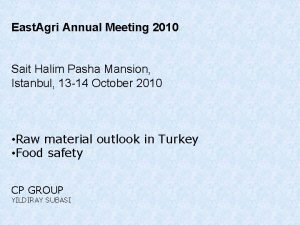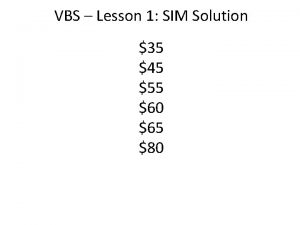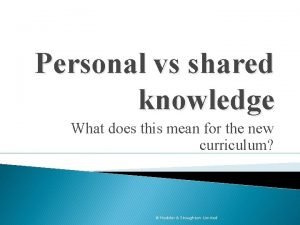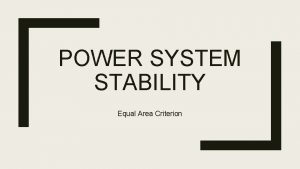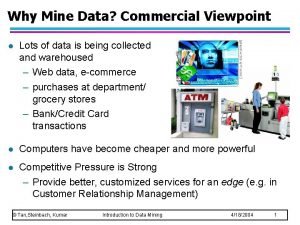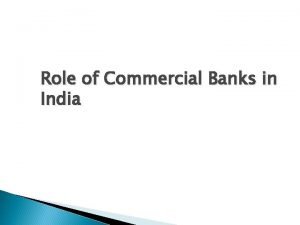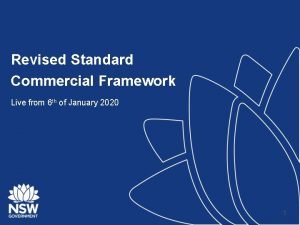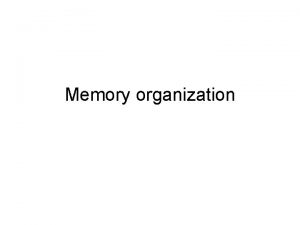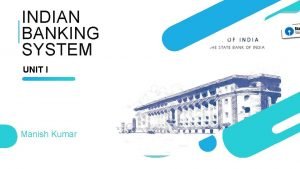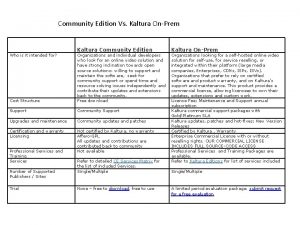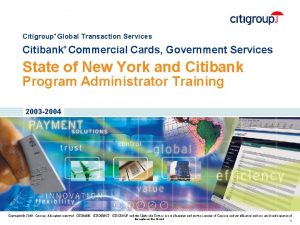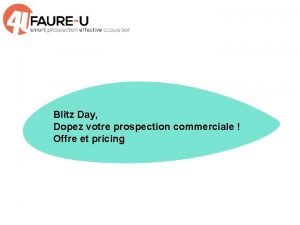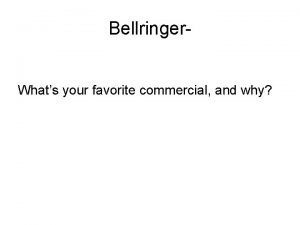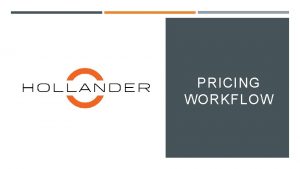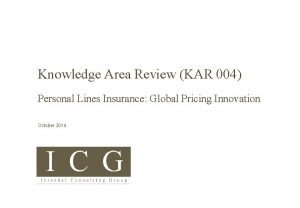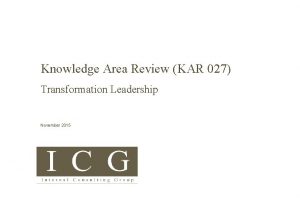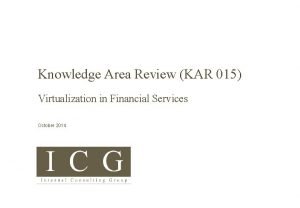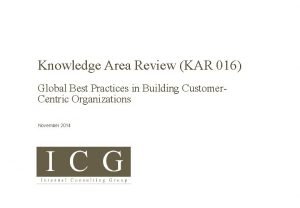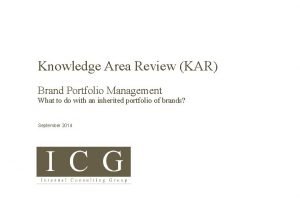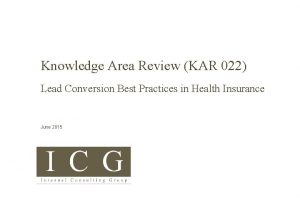Knowledge Area Review KAR 023 Pricing in Commercial











































































































































- Slides: 139

Knowledge Area Review (KAR 023) Pricing in Commercial Banking April 2015

Confidentiality Our clients’ industries are extremely competitive. The confidentiality of companies’ plans and data is obviously critical. ICG will protect the confidentiality of all such client information. Similarly, management consulting is a competitive business. We view our approaches and insights as proprietary and therefore look to our clients to protect ICG’s interests in our proposals, presentations, methodologies and analytical techniques. Under no circumstances should this material be shared with any third party without the explicit written permission of ICG. Disclaimer ICG has made good faith efforts to ensure that this material is a high-quality publication. However, ICG does not warrant completeness or accuracy, and does not warrant that use of the material ICG’s provisioning service will be uninterrupted or error-free, or that the results obtained will be useful or will satisfy the user's requirements. ICG does not endorse the reputations or opinions of any third party source represented in this material. Copyright Notice © 2015 Internal Consulting Group. All rights reserved. . Knowledge Area Reviews provide a synthesis of the leading thinking drawn from global public domain sources from consultants, academics and others. In purchasing this synthesis, buyers agree to the following licensing restrictions. Licensed users are allowed ‘fair use’ of the copyright material for commercial, educational, instructional, and scientific purposes within their organizations. Distribution or reproduction outside of licensed organizations is prohibited. Licensed users must maintain source attribution as identified and indicated on individual slides. While third party materials have been referenced analysed in this material, the content represents the original work of ICG's members. This work is subject to copyright. ICG is the legal copyright holder. No person may reproduce or distribute this material without licensing or the explicit written permission of ICG. Use of the copyright material in any other form, and in any medium whatsoever, requires the prior agreement in writing of the copyright holder. For additional reproduction rights, information on licensing and usage or to buy one of a series of Knowledge Area Reviews and other global publications, go to www. internalconsulting. com/store/ © Internal Consulting Group 2015 KAR 023 – Pricing in Commercial Banking | COMMERCIAL IN CONFIDENCE 2

Pricing in Commercial Banking: Contents Section Component Description 1 Executive Summary Overview of our research and findings 2 Pricing in Commercial Banking A global review of customer relationship pricing from small businesses to larger corporates 2 a Setting the Context: How does commercial banking pricing need to support banks’ underlying strategic priorities? 2 b Pricing for Risk: What are the foundations and how do they need to evolve? 2 c Pricing for Relationship: What are the key best practice principles for relationship pricing? 2 d Implementation Considerations & Challenges: How should banks approach implementation and address the major challenges they will encounter? 2 e What’s Next? What could be around the corner for commercial banking pricing over the next few years? 3 © Internal Consulting Group 2015 Knowledge Sources For each different dimension: • The key thinking from consulting firms, journals and academia as to what constitutes best practice • Examples of this best practice across different firms and industries. Relevant published materials for further reading KAR 023 – Pricing in Commercial Banking | COMMERCIAL IN CONFIDENCE 3

Executive Summary As banks emerge from post-crisis fragility and refocus on value creation, commercial banking pricing has once again been moving up the agenda. Improving pricing capabilities is seen both as an economic necessity and as a bright spot of underleveraged opportunity, with the tangible prospect of substantial, direct, immediate and sustainable impact on the bottom line. So how can banks go about seizing the opportunity? Management of risk remains central and must respond to ongoing and mounting regulatory pressures, but pricing has already moved on to the point where it is driven more by relationship rather by than risk. Banks are attempting to become more customer-centric and more sophisticated in their pricing approaches. At the same time, major new developments – many of them digital-led – promise to disrupt ‘business as usual’ with a tidal wave of innovation. This report draws together the best global thinking and practice from consulting firms, banks, academics, and others to answer five key questions: • • • How does commercial pricing need to support banks’ underlying strategic priorities in the current context? What are the foundations of pricing for risk and how do they need to evolve? What are the key best practice principles in pricing for relationship? How should banks approach implementation and address the major challenges they will encounter? What might be around the corner for commercial banking pricing over the next few years? The focus is on pricing for the core commercial banking business, from the smallest SMEs to larger corporates, but excluding very large companies, where the pricing dynamics can be different. Our aim is to provide a comprehensive, strategic, and action-focused synthesis of material, starting with the macro environment and drilling down to the nuts and bolts of how to do it. We also provide a central navigation point for a large quantity of publicly-available thinking, evidence and experience, with clear and detailed references for further reading. © Internal Consulting Group 2015 KAR 023 – Pricing in Commercial Banking | COMMERCIAL IN CONFIDENCE 4

Pricing in Commercial Banking: Content Overview A review of global best practice Pricing for Relationship Pricing for Risk Setting the Context Value creation Regulation Digitization What is risk pricing? Risk management Risk and relationship and its evolution Customer insight Guidelines and discretion Customer centricity Main banking relationship Risk frameworks Customer satisfaction Risk appetite and determinants of risk Role of pricing Link with strategy The “efficient frontier” and optimizing return Sub-segmentation Bundled pricing Lifetime customer value Multichannel RM discretion Open CRM Integrated approach Risk culture and setting the tone Salesforce effectiveness Synergies with private and retail Pioneering pricing models Recruitment, management and training Agility Customer management, measurement, and feedback Data mining and digitization Behavioural economics Fintech Regulation as a barrier to profitability and innovation Implementation Considerations & Challenges © Internal Consulting Group 2015 Crowdfunding marketplaces Shadow banks Digital-only What’s Next? KAR 023 – Pricing in Commercial Banking | COMMERCIAL IN CONFIDENCE 5

The following describes the traditional taxonomy of Pricing in Commercial Banking: Price for Risk Price for Relationship Analyze/Re-price/ Refine © Internal Consulting Group 2015 Source: derived from Kaplan and Norton, 1996 KAR 023 – Pricing in Commercial Banking | COMMERCIAL IN CONFIDENCE 6

Pricing in Commercial Banking: Contents Section Component Description 1 Executive Summary Overview of our research and findings 2 Pricing in Commercial Banking A global review of customer relationship pricing from small businesses to larger corporates 2 a Setting the Context: How does commercial banking pricing need to support banks’ underlying strategic priorities? 2 b Pricing for Risk: What are the foundations and how do they need to evolve? 2 c Pricing for Relationship: What are the key best practice principles for relationship pricing? 2 d Implementation Considerations & Challenges: How should banks approach implementation and address the major challenges they will encounter? 2 e What’s Next? What could be around the corner for commercial banking pricing over the next few years? 3 © Internal Consulting Group 2015 Knowledge Sources For each different dimension: • The key thinking from consulting firms, journals and academia as to what constitutes best practice • Examples of this best practice across different firms and industries. Relevant published materials for further reading KAR 023 – Pricing in Commercial Banking | COMMERCIAL IN CONFIDENCE 7

Improving the pricing approach in commercial banking is increasingly seen both as both a necessity and an opportunity by banks around the world. Banks are largely out of post-crisis fragility, but are not, on average, meeting their cost of equity, let alone enjoying the profitability levels to which they were accustomed pre-2008. They are pursuing a range of value creation strategies on the road to recovery, and pricing has moved up the overall agenda. Commercial banking has wide variations in performance between different players, but good revenue prospects in all major regions. The banks continue to have a number of complex, interconnected issues on their plate. Experts have different ways of articulating and summarising the key themes, but three stand out with particular prominence – regulation, digitization and customer centricity. • Regulation is affecting banks in many and occasionally contradictory ways. Some, in particular stemming from Basel III, have a direct effect on pricing by changing the cost of capital and the requirements for risk management. Others, such as various forms of conduct regulation, change the rules of the competitive game. • Digitization is having a huge effect on the nature of commercial customers’ interaction with banks and on the economics of serving them, with important implications for pricing strategy. It is also enabling a whole new level of ‘Big Data’ capture and analytics, with pricing amongst the top areas of opportunity. • Increasing customer centricity is being forced by regulation and the need to restore customer trust. For commercial banking pricing, this means a need to focus on longer-term customer satisfaction as well as short-term gain, but it is also a value creation opportunity to tailor pricing more closely to individual customers. In this context, improving commercial banking pricing is seen a key pillar of banks’ strategies, with the potential to deliver substantial, direct, immediate and sustainable impact on the bottom line. © Internal Consulting Group 2015 KAR 023 – Pricing in Commercial Banking | COMMERCIAL IN CONFIDENCE 8

Although banking ROE has returned to its long-term average, banks around the world are still struggling to meet their cost of capital GLOBAL BANKING ROE, 1980 -1 H 2014 GLOBAL BANKING ROE, 1 2000 -13 Percent Value creation No value creation © Internal Consulting Group 2015 KAR 023 – Pricing in Commercial Banking | COMMERCIAL IN CONFIDENCE Source: The Road Back: Mc. Kinsey Global Banking Annual Review 2014 9

Banks are pursuing a range of strategies, a number of which are clearly demonstrating the potential for value creation VALUE CREATION BY TOP 500 BANKS WORLDWIDE BY ASSETS, 2013 1 © Internal Consulting Group 2015 KAR 023 – Pricing in Commercial Banking | COMMERCIAL IN CONFIDENCE Source: The Road Back: Mc. Kinsey Global Banking Annual Review 2014 10

As banks have moved out of ‘survival’ mode, credit portfolio optimization, profitability, and pricing have risen up the agenda GLOBAL RANKING OF RISK PRIORITIES BY BANKS, 2013 (2012 IN BRACKETS) 1 Liquidity risk management (1) 2 Regulatory capital adequacy (2) 3 Credit portfolio optimization (NA) 4 Risk appetite framework (4) 5 Risk-adjusted profitability and relationship pricing (7) 6 Enterprise-wide stress testing (5) 7 Operating risk measurement (NA) 8 Model validation and review (8) 9 Capital planning (3) 10 Market risk for the investment/trading books (NA) © Internal Consulting Group 2015 KAR 023 – Pricing in Commercial Banking | COMMERCIAL IN CONFIDENCE Source: Key risk management challenges for 2013/2014: results of our global risk survey, July 2013, Sunguard Capital Markets 11

In commercial/corporate banking, there are large and increasing variations in performance within most geographies PROFITABILITY FOR CORPORATE BANKING DIVISIONS GLOBALLY, 2007 & 2013 Pretax return on regulatory capital (%) © Internal Consulting Group 2015 KAR 023 – Pricing in Commercial Banking | COMMERCIAL IN CONFIDENCE Source: BCG Global Corporate Banking 2015: The Look of a Winner 12

Commercial/corporate banking profitability trends are challenging… PROPORTION OF CORPORATE BANKING DIVISIONS (%) © Internal Consulting Group 2015 KAR 023 – Pricing in Commercial Banking | COMMERCIAL IN CONFIDENCE Source: BCG Global Corporate Banking 2015: The Look of a Winner 13

…but commercial/corporate banking revenue growth forecasts for the next five years look good FORECAST OF CORPORATE BANKING REVENUE BY REGION ($billions) © Internal Consulting Group 2015 KAR 023 – Pricing in Commercial Banking | COMMERCIAL IN CONFIDENCE Source: BCG Global Corporate Banking 2015: The Look of a Winner 14

Regulation is still the most significant concern for banks and creates major profitability – and hence – pricing challenges EXAMPLE QUOTES ON REGULATION Last year, we wrote that banks had made many of the more difficult adjustments and were coming to grips with some of the remaining uncertainties. Over the past year, however, regulatory reform has gained momentum, and is clearly now the most powerful external dynamic affecting banks; furthermore, it shows no sign of diminishing. Pressure is increasing in four areas: the supervisory regime, the balkanisation of bank regulation, the rising expectations regarding banks’ conduct and control mechanisms, and policies in some countries that will reduce the attractiveness of banking. © Internal Consulting Group 2015 Corporate bankers have been working steadily on compliance with Basel III and other new waves of regulation, including anti-money-laundering and anti-terrorist-financing measures. We are also seeing “know your client” initiatives, sanctions monitoring and, in some countries, new requirements concerning business conduct and fair treatment of clients. In the long run, new regulations may affect the corporate banking business even more than anticipated. While crisis-era margin increases are eroding, compliance costs are here to stay. Basel III capital and liquidity mandates are fundamentally changing the economics of some corporate banking products and customer segments. KAR 023 – Pricing in Commercial Banking | COMMERCIAL IN CONFIDENCE Source: The Road Back: Mc. Kinsey Global Banking Annual Review 2014; BCG Global Corporate Banking 2015: The Look of a Winner 15

Digital has passed or is rapidly passing the tipping point of adoption across the world SHARE OF REVENUE FROM DIGITAL SALES, 2013 Percent © Internal Consulting Group 2015 KAR 023 – Pricing in Commercial Banking | COMMERCIAL IN CONFIDENCE Source: The Road Back: Mc. Kinsey Global Banking Annual Review 2014 16

Big Data has multiple applications within banking, many of which may be relevant for commercial pricing EXAMPLE APPLICATIONS OF BIG DATA IN FINANCIAL SERVICES © Internal Consulting Group 2015 KAR 023 – Pricing in Commercial Banking | COMMERCIAL IN CONFIDENCE Source: How the financial services industry can unlock the value in Big Data, Pw. C FS viewpoint, 2014 17

Banks are attempting to become more much more customer-centric “TEN TIMELESS TESTS”: HOW CUSTOMER-CENTRIC IS YOUR BANK? Banks realize that they can no longer afford to develop products and services without paying close attention to customer needs. It is already clear who will come out ahead: those banks that regain the trust as well as hearts and minds of their customers with target-specific offers. The future belongs to banks that give the customer center stage in their business model. © Internal Consulting Group 2015 KAR 023 – Pricing in Commercial Banking | COMMERCIAL IN CONFIDENCE Source: ‘Banking on Customer Centricity: Transforming banks into customer-centric organizations’, Mc. Kinsey EMEA Banking Practice, 2012 18

Credit capabilities and value-based pricing are two of the key forward-looking pillars for a winning commercial/corporate bank BCG FRAMEWORK: EIGHT ACTIONS TO BE A WINNING BANK IN 2020 © Internal Consulting Group 2015 KAR 023 – Pricing in Commercial Banking | COMMERCIAL IN CONFIDENCE Source: BCG Global Corporate Banking 2015: The Look of a Winner 19

Pricing in Commercial Banking: Contents Section Component Description 1 Executive Summary Overview of our research and findings 2 Pricing in Commercial Banking A global review of customer relationship pricing from small businesses to larger corporates 2 a Setting the Context: How does commercial banking pricing need to support banks’ underlying strategic priorities? 2 b Pricing for Risk: What are the foundations and how do they need to evolve? 2 c Pricing for Relationship: What are the key best practice principles for relationship pricing? 2 d Implementation Considerations & Challenges: How should banks approach implementation and address the major challenges they will encounter? 2 e What’s Next? : What could be around the corner for commercial banking pricing over the next few years? 3 © Internal Consulting Group 2015 Knowledge Sources For each different dimension: • The key thinking from consulting firms, journals and academia as to what constitutes best practice • Examples of this best practice across different firms and industries. Relevant published materials for further reading KAR 023 – Pricing in Commercial Banking | COMMERCIAL IN CONFIDENCE 20

Risk is often the starting point for the pricing of a client relationship TOPIC 1 DESCRIPTION What is risk-based pricing? 2 3 Frameworks, guidelines and discretion Risk appetite and the “Efficient Frontier” © Internal Consulting Group 2015 Source: ICG Analysis. Risk-based pricing attempts to match the price a borrower pays to the cost incurred by the lender through tailoring the price of the credit available to a borrower’s probability of default. Its advantages include a fairer outcome for borrower. For the bank: improved data analysis, statistical modeling, and risk-based pricing becomes a competitive edge and drives growth. Financial institutions have gone through an evolution in their risk management approaches over the past 20 years. More recent changes have taken place in the Commercial Banking realm, and are following a similar path to other business silos. Regulatory and rating agencies now require banks to align various stakeholder objectives to better balance strategy, capital, and risk. Once the risk appetite is set, it needs to be embedded and then continuously monitored and revised. With increasing capability and information sources, banks can manage their loan book closer to the “Efficient Frontier”. The result: increased profitability. KAR 023 – Pricing in Commercial Banking | COMMERCIAL IN CONFIDENCE 21

Risk-based pricing attempts to match the price a borrower pays to the cost incurred by the lender through tailoring the price of the credit available to a borrower’s probability of default 1 WHY RISK-BASED PRICING? • All creditors face a risk-spectrum of potential borrowers. Each borrower has unique characteristics that influence the probability of default on their credit. Higher-risk borrowers are more costly for lenders to serve than lower-risk borrowers. Risk-based pricing attempts to match the price a borrower pays to the cost incurred by the lender through tailoring the price of the credit available to a borrower’s probability of default. • By tailoring its pricing to individual borrowers, a single creditor can effectively compete for low-risk customers while simultaneously (and specifically) offering credit services to higher-risk borrowers at higher prices. • If a creditor developed the risk management tools to sort low-risk from high-risk borrowers at the time of the loan application, it could identify and compete for low-risk borrowers by offering credit at lower rates but with tougher qualifying standards. • In this environment, an established creditor with a portfolio of credit must cut its own rate to its low-risk customers, or risk losing them to the competition. This process repeats across every risk group. • As a result, a competitive lending market provides borrowers the best rate for their risk profile. • Without risk-based pricing, higher-risk borrowers will not be able to access credit at any price, because a lender whose portfolio includes too many high-risk borrowers will have to raise the average rate offered, and that will drive away the lower-risk borrowers. • Consistent and accurate (and replicable) pricing of loans and other products is becoming crucial from both business and regulatory perspectives – this section overviews the importance of risk pricing. © Internal Consulting Group 2015 KAR 023 – Pricing in Commercial Banking | COMMERCIAL IN CONFIDENCE Source: adapted from Risk-Based Pricing in Consumer Lending, Center for Capital Markets Competitiveness, 2014. 22

Pricing is a critical aspect of asset and liability management for financial institutions WHY AND FI BENEFITS RISK-BASED PRICING METHODOLOGY • To compete and to deliver adequate returns to shareholders, leading institutions are beginning to scrutinize their operations to ensure their earning assets are effectively deployed • Financial institutions need to clearly define, measure and price their risks, and control their costs in order to meet profit maximization objectives: • For an institution, the following are the benefits of risk-based pricing: Additional Margin: Represents the target return on equity, i. e. the new rate of return expected by shareholders. Guided by economic fundamentals and the long term sustainability of the institution. Capital Cost: The product of hurdle rate and economic capital Risk Costs: The expected loss that institution will suffer. The product of Probability of Default, Loss Given Default, and Exposure of Default 1 Operating Costs: Includes indirect cost/overheads and statutory costs such as deposit insurance premium, case reserve requirements, opportunity cost of holding liquid assets in excess of minimum requirements, and the cost of holding non-earning assets Funding Costs: Represents the interest expense related to the monthly average volume of deposits and other funds reported to the regulator on a monthly basis • Early knowledge of price/fees vs risk/return preferences • Enhances shareholder value by ensuring credit risk is appropriately measured and priced • Improves relationship profitability • Enhances the achievement of portfolio goals and objectives • Satisfies regulatory requirements. © Internal Consulting Group 2015 Source: Risk Based Pricing, KPMG January 2011 KAR 023 – Pricing in Commercial Banking | COMMERCIAL IN CONFIDENCE 23

The vast majority of credit decisions today are based on objective data regarding a borrower’s own past payment history and current obligations (1) 1 • The vast majority of credit decisions today are based on objective data regarding a borrower’s own past payment history and current obligations. FAIRNESS • Credit scoring and risk-based pricing have dramatically increased the consistency of creditors’ lending decisions and the likelihood of equal treatment across applicants. • Compared with a one-price-fits-all system, a borrower in a market characterized by risk-based pricing is also less likely to be paying for the costs imposed by someone else’s behaviour. FINANCIAL INCLUSION • Credit scoring and risk-based pricing triggered a massive expansion in credit opportunities for consumers across the socioeconomic spectrum. Between the early 1980 s and 2001, the lower half of the income distribution experienced 200%-300% increases in the percentage of households with access to general purpose credit cards and 30%-70% increases in access to other types of loans. Similar impacts can be seen in the Commercial Lending environment with the introduction of risk-based (or tiered) pricing algorithms. • A 2007 Federal Reserve report that found that “risk-based pricing expands access to credit for previously credit-constrained populations, as creditors are better able to evaluate credit risk, and, by pricing it appropriately, offer credit to higher-risk [creditors]. ” © Internal Consulting Group 2015 KAR 023 – Pricing in Commercial Banking | COMMERCIAL IN CONFIDENCE Source: Adapted from Risk-Based Pricing in Consumer Lending, Center for Capital Markets Competitiveness, 2014. 24

The vast majority of credit decisions today are based on objective data regarding a borrower’s own past payment history and current obligations (2) INNOVATION 1 • Improved data analysis, statistical modeling, and risk-based pricing becomes a competitive edge. ”One of the virtues of scoring as a decision assistance tool is that new data improves the ability of these models to fine tune a lender's assessment of risk, ” Staten writes. As more data is processed and credit scoring tools are improved, risk-based pricing leads to expanded credit access. • Rather than shutting higher-risk borrowers out of the market, scoring and risk-based pricing have given lenders the tools and incentives they need to say “yes” to loan applications from a far wider cross-section of the population than ever before. • Credit markets that make loans accessible to large segments of the population provide a cushion that neutralizes the macroeconomic drag associated with temporary declines in income, lowering the risk of outright recession and reducing the magnitude of downturns when they do occur. ECONOMIC GROWTH © Internal Consulting Group 2015 • From a labor market perspective, the ability of lenders to tap and utilize the detailed information in our credit reporting system has increased the mobility of the U. S. population. As a result, structural shifts within the economy can cause temporary employment disruptions without crippling long-term effects. KAR 023 – Pricing in Commercial Banking | COMMERCIAL IN CONFIDENCE Source: Risk-Based Pricing in Consumer Lending, Center for Capital Markets Competitiveness, 2014. 25

Since the 2000’s, Commercial Lending, risk-based pricing has been used in various applications such as business loans, credit card loans, trade credit, and equipment leasing 1 THE ROLE OF CREDIT SCORING • Credit scoring evolved to help lenders utilize the data in credit reports more efficiently. Until the mid-1960 s, consumer lending decisions in the United States were made individually by thousands of loan officers who exercised their individual judgment with each application. • The post-World War II boom in consumer lending increased the pressure on retailers and consumer finance companies to efficiently process a rising tide of loan applications. The human-judgmentbased approach to consumer loan underwriting was slow and labour-intensive, and the inconsistency inherent in a judgmental approach rendered a company-wide underwriting policy nearly impossible. • Credit scoring gave lenders a powerful tool for rapidly and consistently evaluating default risk, as well as summarising that risk with a numerical score. • By the 1980 s, the published studies of scoring were reporting significant reductions in loan losses with little or no sacrifice of loan volume. This is because credit scoring allows a better match of borrowers to loans. • Since the 2000’s, Commercial Lending, risk-based pricing has been used in various applications such as business loans, credit card loans, trade credit, and equipment leasing. Its popularity has increased in recent years due to its financial benefits. Generally, those who have properly implemented risk-based pricing have reported increases in customer base, number of approved loans, and loan-to-savings ratio and reduced delinquency rates. © Internal Consulting Group 2015 KAR 023 – Pricing in Commercial Banking | COMMERCIAL IN CONFIDENCE Source: Risk-Based Pricing in Consumer Lending, Center for Capital Markets Competitiveness, 2014. 26

Financial institutions have gone through an evolution in their risk management approaches over the past 20 years. 2 • Beginning with retail credit and continuing to mortgages and credit cards, these advances have made significant impacts on the growth and performance of credit across many lines of business. More recent changes have taken place in the Commercial Banking realm, and are following a similar path to other business silos. • Research suggests that risk management in any line of business takes place through a series of evolutionary stages. While the specific nature of the evolution varies from bank to bank, typically this evolution is in seven stages, with each successive stage representing progress from the previous stage on a least some dimensions. • An intriguing observation is that on two of the stages, the overall quality of credit decision-making declines relative to the previous stage due to the uneven development of critical elements. These setbacks can be avoided through a carefully structured integration of the developments in finance and technology that are driving the change. • Virtually all lines of business would profit from a sharper management focus on improving credit risk management. Even those which have not recently experienced loan loss problems will benefit from evolving their practices. • Sophisticated credit risk management is a requirement to avoid adverse selection problems and to remain viable against leading bank and non-bank competitors. © Internal Consulting Group 2015 Source: The Seven Stages of Risk Management, ERISK, 1999 KAR 023 – Pricing in Commercial Banking | COMMERCIAL IN CONFIDENCE 27

Wherever they find themselves on the stages of the continuum, Commercial Banks follow a staged, evolutionary development path towards stage seven 2 Commercial Banking Today I VII All key decision-making processes – credit approval, monitoring and pricing – are decentralized and judgmental The improved information systems and analytical foundation guide the bank to a conclusion that diversification is paramount to achieving risk/return efficiency II The relative riskiness of different loans is formally recognized through the introduction of a loan grading scale III Management begins to drive an ROE culture into the bank to maximize shareholder value and an established ROE hurdle rate © Internal Consulting Group 2015 Source: The Seven Stages of Risk Management, ERISK, 1999 VI Portfolio management theory can now be applied successfully to a loan book due to advances in the bank’s risk measurement analytics IV A series of key risk measurement advances allow the successful implementation of the ROE culture attempted in Stage III V Key Bank management seeks to apply modern portfolio theory to the management of the loan book KAR 023 – Pricing in Commercial Banking | COMMERCIAL IN CONFIDENCE 28 # Typical Advance # Real Advance

Increasing regulatory demands, advances in technology, real time market-based monitoring, along with the increasing availability of “Big Data” are driving commercial banks towards Stage VI Stage of Development Our shareholders demand risk/ return efficiency Positioning Portfolio management theory can now be applied successfully to a loan book due to advances in the bank’s risk measurement analytics (value is released in this stage: bank-wide exposure monitoring will consolidate data from various product-oriented accounting systems and improved accuracy and consistency of internal loan grade) VI Other Characteristics Advances include: better risk discrimination at the borrower level; correlation measurement which accounts appropriately for default interrelationships caused by industry, geography and macroeconomic factors, and ties to the experience of senior credit officers; implementation of techniques to quantify accurately the unique unexpected loss contribution of each credit exposure. Measurement advances allow for the development of a coherent management framework with more robust metrics – volatility, exposure, counterparty risks, etc. More communication between centre and field, and an increasingly dominant role for centralized units in the grading, pricing and approval of new credits. © Internal Consulting Group 2015 Source: The Seven Stages of Risk Management, ERISK, 1999 KAR 023 – Pricing in Commercial Banking | COMMERCIAL IN CONFIDENCE 29 2

Significant limitations to risk-based pricing must be taken into account by lenders LIMITATIONS TO RISK-BASED PRICING • Limits to price differentiation. While existing risk models (including credit scoring) are effective and do rank-order risk, they are not perfect. The probabilities of default can be effectively identified, but they are only probabilities – these analytical methods cannot identify which accounts at each score range will pay and which ones will not. • Negative customer reactions. The standards of fairness can be disturbed if the customer response is based on a comparison of the current price to a hypothetical willingness to pay, which encompasses deep notions of fairness. Risk-based pricing strategies could also be perceived as classist, or a form of racial or gender discrimination. • Risk-response relationship. High quality borrowers as identified by risk models are likely to be the target of many lenders. They are offered better deals than customers deemed to be a higher risk. It is well established that there is usually an inverse relationship between risk and response. Hence, the probability that customers will take a particular loan is likely to be lower than the higher-risk customers. • Adverse selection. This occurs when there is asymmetric information between the buyer and the seller of a contract. A bank suffers asymmetric information when it is unable to distinguish between two applicant projects with different risk levels, when assigning credit. • Adverse selection also means that riskier borrowers are willing to pay higher interest rates than safer borrowers. Under differential pricing, there is a powerful motivation for customers in high-price segments to find a way to avoid revealing their true willingness to pay and the pay the lower price. In this situation, the bank knows that it has less © Internal Consulting Group 2015 information than the applicants, and therefore protects itself by raising the interest rate charged to every applicant. This excludes some safer borrowers (who have a lower willingness to pay) and increases the proportion of bad loans on the books. • Affordability. The interest rate charged may also affect the borrower’s ability to pay back the loan. A borrower, for instance, may be able to service a loan at five percent, and therefore likely maintain good behaviour. However, at ten or twenty percent that may not be the case. • Risk distribution skewed or uncertainty over the distribution of risks. When banks customize prices to each identified group of risks, they may involuntarily worsen the average risk level of loans in their portfolio as a whole. Risk-based pricing can cause adverse selection if risk distributions are non-uniform. Even when there is a uniform distribution of risks, banks may remain adverse to customizing prices if there are doubts about the true shape of the distribution. For instance, the number of potential borrowers in each of the risk categories could vary considerably over time. This may deter the bank from implementing risk pricing. • These shortcomings can be mitigated by having a robust analytical capacity to collect, interpret, and communicate information pertaining to risk as accurately as possible. KAR 023 – Pricing in Commercial Banking | COMMERCIAL IN CONFIDENCE Source: Risk-based pricing: when does it work and when does it not? Experian, 2013. 30 2

Financial institutions need a risk appetite framework in place to help them understand manage risks 3 Conceptual Corporate Strategy Corporate B Risk Culture D Corporate Level • Business Portfolio Decisions (Strategic/non-strategic) • Key Performance Indicators (KPIs) • Corporate-level Risk Tolerances A Stakeholder Objectives C • Measure Infrastructure & Indicators Reporting & Monitoring Infrastructure Business Unit Level Risk tolerances per risk category Credit Risk Financial Risk Operational Risk Reputational Risk Other Risk E © Internal Consulting Group 2015 Risk Limits/ targets per risk category Credit Risk Set Risk Appetite Financial Risk Operational Risk Embed Risk Appetite Reputational Risk Other Risk Monitor Risk Appetite/ Mitigate Risks KAR 023 – Pricing in Commercial Banking | COMMERCIAL IN CONFIDENCE Source: A Comprehensive Risk Appetite Framework for Banks, Booz & co. , 2009. Policies & Guidelines Accountability & Consequences Department/Product Level • Capabilities Revise Risk Appetite 31

Deploying a risk appetite framework identifies and quantifies risks in the context of a firm’s business objectives and strategy CONSCIOUS, RIGOROUS RISK-TAKING • No business can thrive without taking on risks. • The tradeoffs between risk and reward in a RAF are made up front, in a conscious attempt to decide the right calibration, and at a firm-wide level. • An appetite for credit losses, for example, can be formulated and limits and triggers can be set to warn the organization if actual exposure is moving too far above or below the desired level. • A risk appetite framework uses a rigorous approach to all of a firm’s risks, works out the linkages between those risks and its overall strategy. • Because it is the collective impact of risk-taking enterprise-wide that is being managed, a great deal of coordination across the firm and alignment between broader objectives of business units, and a translation between the technical language of the risk specialist and the more general enterprise-wide risk appetite language are all required. • A well-engineered RAF allows this collaboration and cross-unit sharing of information. • Firstly, RAFs facilitate top-down direction the Board via the cascading of risk appetite statements and their ongoing monitoring and control – in a risk appetite language that is meaningful to all. • Secondly, they rely on bottom-up information and insight from the businesses and control functions through the calibration of risk appetite limits and triggers, as well as the reporting of risk and the risk profile versus risk appetite. © Internal Consulting Group 2015 KAR 023 – Pricing in Commercial Banking | COMMERCIAL IN CONFIDENCE Source: Risk Appetite Frameworks: How to Spot the Genuine Article, Deloitte, 2013. 32 3 A

Regulators and ratings agencies are requiring that banks align KPIs with stakeholder objectives 3 A CONVERSION OF STAKEHOLDER OBJECTIVES TO KPI(S) • In the past, alignment with stakeholder objectives centred on strategy and capital; now risk is also a key consideration. • Each stakeholder objective will have a different influence on the optimal tradeoffs among capital, risk, and strategy. • KPIs translate stakeholder objectives into a metric that can be measured and managed. • Potential KPIs include: • Capital adequacy • Earnings volatility • Shareholder value (e. g. RAROC, EPA) • Reputation; and • Creditworthiness © Internal Consulting Group 2015 KAR 023 – Pricing in Commercial Banking | COMMERCIAL IN CONFIDENCE Source: A Comprehensive Risk Appetite Framework for Banks, Booz & co. , 2009. 33

High-level corporate KPIs are defined and operationalized, with risk appetite and tolerances established for each Illustrative KEY PERFORMANCE INDICATORS Once a core set of KPIs are defined in alignment with stakeholder objectives, those KPIs must be translated into measurable categories. For example, capital adequacy can be measured by looking at these three ratios: • Tier 1 Common Capital/Risk. Weighted Assets • Tier 1 Total/ Risk Weighted Assets • Tier 1 Total/ Economic Capital Next, risk appetite levels need to be set, and risk tolerances established, for the core KPIs. Senior management and the board need to review and approve both risk appetite and tolerances for selected KPIs. © Internal Consulting Group 2015 KAR 023 – Pricing in Commercial Banking | COMMERCIAL IN CONFIDENCE Source: A Comprehensive Risk Appetite Framework for Banks, Booz & co. , 2009. 34 3 B

The desired risk appetite helps facilitate business portfolio decisions based on a comparison of risk-return profiles Illustrative BUSINESS PORTFOLIO DECISIONS For each business ask: • Are there clear intentions (continue, review, or divest)? • Should it be grown, contracted, or maintained? • Should its risk be increased, decreased, or maintained? • Should controls be increased, decreased, or maintained? © Internal Consulting Group 2015 KAR 023 – Pricing in Commercial Banking | COMMERCIAL IN CONFIDENCE Source: A Comprehensive Risk Appetite Framework for Banks, Booz & co. , 2009. 35 3 B

For specific risk management purposes, risk appetite and tolerances are defined for all major risk categories 3 B Illustrative CORPORATE LEVEL RISK APPETITE AND TOLERANCES • Risk appetite is usually expressed in risk measures (e. g. value at risk), nominal measures (e. g. $ amount of credit outstanding), or outcomes (e. g. capital level). • Efforts to manage risk appetite and risk tolerance will necessarily focus on those risk categories that have the highest percentage of total economic capital allocated to them. • Aggregation of risk tolerances ensures that the bank operates in line with its desired overall risk appetite. © Internal Consulting Group 2015 KAR 023 – Pricing in Commercial Banking | COMMERCIAL IN CONFIDENCE Source: A Comprehensive Risk Appetite Framework for Banks, Booz & co. , 2009. 36

Risk appetite and tolerances are then sent to business units with limits and targets for departments Illustrative RISK APPETITE AND TOLERANCES FILTER DOWN TO BUSINESS UNITS • This example illustrates the tradeoffs between strategy, capital, and risk. To meet the growth targets of their respective strategic plans, each business unit must pitch Corporate for additional economic capital, incorporating a risk-based view. • Targets are set on the basis of desired risk/return profile and management’s capacity to manage each risk. • Limits help translate appetite and tolerances into practical constraints on business activity. © Internal Consulting Group 2015 EXAMPLE OF RISK APPETITE AND TOLERANCE DRILL-DOWN Corporate-Level Credit Risk Economic Capital: $12 B Business Unit Commercial Credit Risk Economic Capital: $6 B Business Unit Investment Credit Risk Business Unit Retail Credit Risk Economic Capital: $4 B Economic Capital: $2 B Examples of Business Unit-Specific Risk Indicators • • Concentration limits Single name limits Asset quality Average rating score • Credit bureau score • Asset quality KAR 023 – Pricing in Commercial Banking | COMMERCIAL IN CONFIDENCE Source: A Comprehensive Risk Appetite Framework for Banks, Booz & co. , 2009. 3 C • • External credit rating Concentration limits Single name limits Asset quality 37

Specific capabilities are required to successfully implement and manage a risk appetite framework 3 D CAPABILITY REQUIREMENTS Measurement Infrastructure & Indicators Reporting & Monitoring Infrastructure Policies & Guidelines Accountabilities & Consequences © Internal Consulting Group 2015 • At the corporate level, develop a comprehensive set of KPIs and high-level tolerances for all risk categories. • At the business unit and product level, develop risk tolerances for all relevant risk categories • Ensure that all data for defined KPIs is readily available as needed. • Develop a high-level corporate risk appetite and tolerances dashboard for senior management and board as well as individual dashboards for major business units with detailed appendices, covering all relevant risk categories. • Define monitoring responsibilities and frequencies within business units and the risk management function. • Risk appetite and tolerance adherence needs to be consistently embedded in all risk-related policies and guidelines. • Ensure that risk appetite statement is aligned with overall corporate risk philosophy and culture. • Define clear responsibility for setting, approving, and reviewing risk appetite and tolerances. • Establish and communicate escalation mechanisms and consequences for breaches of limits and tolerances. • Put in place good communication, understanding, and agreement across all organizational levels. KAR 023 – Pricing in Commercial Banking | COMMERCIAL IN CONFIDENCE Source: A Comprehensive Risk Appetite Framework for Banks, Booz & co. , 2009. 38

After risk appetite is set, it should be embedded, continuously monitored, and revised Set Risk Appetite Key Activities Output Embed Risk Appetite Monitor Risk Appetite/ Mitigate Risks 3 E Revise Risk Appetite • Set desired risk appetite by considering: • Business strategy • Economic conditions • Ensure alignment with business strategy • Obtain board signoff of risk appetite statement • Cascade the risk appetite down through he bank: • At the portfolio level • At the BU level within portfolios • Align compensation and culture with risk appetite. • Embed governance • Regularly monitor as-is risk profile against the risk appetite • Support monitoring with: • Relevant infrastructure • Appropriate processes • Mitigate unwanted risks • Review risk appetite in light of: • Changing business and economic conditions • Evolving group- and portfolio-level strategic priorities • Changing competitive conditions • Clearly defined risk appetite statement containing both qualitative and quantitative elements. • Risk appetite that is defined a the most granular level possible while still remaining actionable • Clear understanding of the risk appetite by all executives: • At the portfolio level • At the BU level within portfolios • Buy-in from executives to run the businesses in line with the risk appetite • Risk profile reports containing: • Assessment of risk profile against risk appetite • Mitigating actions to align risk profile with risk appetite • Other key findings • Revised risk appetite statement © Internal Consulting Group 2015 KAR 023 – Pricing in Commercial Banking | COMMERCIAL IN CONFIDENCE Source: A Comprehensive Risk Appetite Framework for Banks, Booz & co. , 2009. 39

With increasing capability and information sources, Banks can manage their loan book closer to the “Efficient Frontier”. The result: increased profitability 3 THE EFFICIENT FRONTIER B Strategic Effectiveness – e. g. through significant technological change Financial institutions can limit their credit performance by operating too far from the efficient frontier (that place that optimizes revenue and relative cost) 25 • New frontier opportunity given stronger strategic positioning (innovation & risk/return) A 20 Midpoint Strategy Revenue ($B) 15 Increase concurrence within approved parameters (same risk tolerance, greater volume, higher margin deals) 10 -20 -10 0 10 20 Productivity Frontier (state of best practice) 30 In the example (A), the FI is not maximizing its performance and leaving uncaptured revenue on the table (i. e. could approve more loans within the agreed risk parameters) As technology or other innovations are introduced, FIs can also miss the opportunity to move to the new frontier • In the example (B), the FI is not optimizing its position by failing to leverage the new frontier (e. g. data, technology, new products, streamlined processes, etc. ) 40 High/Better Low/Worse Relative Loan Loss Position (bp) © Internal Consulting Group 2015 KAR 023 – Pricing in Commercial Banking | COMMERCIAL IN CONFIDENCE Source: Michael Porter re: operational efficiency vs. strategic effectiveness 40

Pricing in Commercial Banking: Contents Section Component Description 1 Executive Summary Overview of our research and findings 2 Pricing in Commercial Banking A global review of customer relationship pricing from small businesses to larger corporates 2 a Setting the Context: How does commercial banking pricing need to support banks’ underlying strategic priorities? 2 b Pricing for Risk: What are the foundations and how do they need to evolve? 2 c Pricing for Relationship: What are the key best practice principles for relationship pricing? 2 d Implementation Considerations & Challenges: How should banks approach implementation and address the major challenges they will encounter? 2 e What’s Next? What could be around the corner for commercial banking pricing over the next few years? 3 © Internal Consulting Group 2015 Knowledge Sources For each different dimension: • The key thinking from consulting firms, journals and academia as to what constitutes best practice • Examples of this best practice across different firms and industries. Relevant published materials for further reading KAR 023 – Pricing in Commercial Banking | COMMERCIAL IN CONFIDENCE 41

We have identified a number of key best-practice principles for improving customer relationship pricing in commercial banking (1) The previous section has talked about pricing for risk. However, commercial banks are now evolving their pricing approaches to optimize the customer relationship, including factors of competition, satisfaction and elasticity. Indeed, these broader relationship factors are often far more significant in overall pricing outcomes than the traditional ‘fundamentals’. There is no one-size-fits-all approach, but our global review suggests several key best-practice principles for improving customer relationship pricing in commercial banking: • Drive pricing from strategy. For example, the different financial dynamics of banks’ overall value creation strategies can lead to widely varying targets for key metrics and many banks are establishing distinctive price positions. • Gain deep insight into real customer needs, attitudes and behaviours. Theoretical or apparently common -sense approaches based on standard models of competition and shopping around can be positively misleading – studies often find that ‘it’s just not like that’. Moreover, commercial customers are demanding greater understanding of their needs from their banks. • Focus on gaining, growing and keeping the main banking relationship, which is more profitable, more loyal and less risky. Profitability can be further enhanced by driving take-up of additional products. • Given the need to be more customer-centric and to encourage long-term loyalty, use pricing to help drive longer-term customer satisfaction rather than focusing purely on its impact on attraction and switching behaviours. Pricing satisfaction can be broken down into a number of dimensions which change in salience through the customer’s buying cycle and whose relative importance for a particular customer group can be quantified through research. © Internal Consulting Group 2015 KAR 023 – Pricing in Commercial Banking | COMMERCIAL IN CONFIDENCE 42

We have identified a number of key best-practice principles for improving customer relationship pricing in commercial banking (2) • Take a sub-segmented approach to commercial customers. A number of lenses can be useful for pricing approaches, including start-up vs. existing, size/complexity, relationship appetite and volume. More sophisticated players are adopting a large number of granular, needs-based sub-segments. • Adopt bundling best practices which appeal to customers and lock in profitable relationships but do not destroy high-margin opportunities. • Manage for customer lifetime value through explicitly estimating future cash flows over a longerterm horizon than a single year, including an estimation of ‘wallet size’. However, care must be taken to avoid over-discounting in anticipation of future sales which do not materialize and the potential for unprofitable cross-selling. • Develop an explicit approach to multichannel pricing strategy. Given the radically different economics of customer servicing across channels, this can mean differential pricing. However, some banks have successfully taken the opposite approach of cross-channel price consistency. • Leverage synergies between commercial, private and retail banking, especially at the smaller end of the market, where they are often more closely intertwined. One of the strongest links here is the influence of start-up owners’ personal banking relationships on their choice of a business bank. • Limit RM pricing discretion, in favour of more data-driven approaches. Best practice is for an element of RM discretion only for higher-value customers, with close monitoring of exceptions and overrides. © Internal Consulting Group 2015 KAR 023 – Pricing in Commercial Banking | COMMERCIAL IN CONFIDENCE 43

Commercial banks are evolving their pricing approaches well beyond cost and risk STAGES IN THE EVOLUTION OF COMMERCIAL LOAN PRICING Ad hoc Cost-based • Decentralized, RM discretion • RAROC used in loan pricing • Limited data, analytics or tools • Defines the “floor” price, which often ends up as the “ceiling” as RMs negotiate down Competitor-based • Systematic monitoring and use of market data sources • Identification of regional pricing differences, plus tradeoffs in spreads vs. fees Elasticity-based • Incorporates models of price elasticity • Models provide a demand-based “ceiling, ” which is integrated with a cost-based “floor” • RMs supported by a broader set of data/analytics Optimization • Price optimization model used to maximize loan revenue/growth across franchise • Includes an enhanced technology platform to support RM negotiation Typical stage of more advanced banks today © Internal Consulting Group 2015 KAR 023 – Pricing in Commercial Banking | COMMERCIAL IN CONFIDENCE Source: Improving Commercial Loan Pricing, Novantas Review Vol 5, No. 1, 2014 44

Commercial banking pricing is now primarily driven by relationship, process, and market factors rather than cost and risk – even for loans COMMENTS Deal fundamentals (25% to 30% influence) Relationship, process and market factors (70% to 75% influence) Credit characteristics • Credit grade • Facility grade • Expected loss Relationship factors • Revenue & profitability • Tenure; tier • Share of wallet Loan characteristics • Type of loan/line • Size of loan • Term of loan • Fixed vs. variable • New vs. renewal • Loan fees; amortization • Collateral; other Process factors • Relationship managers - Behaviors & skills - Goals & incentives - Support tools • Management - Line of business - Field team • Central guidance - Analytics/tracking Borrower characteristics • Industry sector • Geography • Annual sales © Internal Consulting Group 2015 • Novantas, a banking analytics and advisory firm, carried out statistical analyses of LIBOR-equivalent spread variance among multiple commercial loan portfolios • ‘Fundamentals’ like credit risk and loan type explained only around 25 -30% of the variance. • Adding in basic borrower characteristics such as sector, location and revenue did not materially raise the explanatory power of the ‘fundamentals’. • They concluded that 70 -75% of pricing is determined by relationship, process and market factors. Market factors • Competitive dynamics KAR 023 – Pricing in Commercial Banking | COMMERCIAL IN CONFIDENCE Source: Improving Commercial Loan Pricing, Novantas Review Vol 5, No. 1, 2014 45

Banks’ valuation creation strategies have different financial dynamics, with strong implications for the metrics that pricing needs to achieve SELECTED PERFORMANCE METRICS OF TOP 90 BANKS GLOBALLY, 2013 Percent © Internal Consulting Group 2015 KAR 023 – Pricing in Commercial Banking | COMMERCIAL IN CONFIDENCE Source: The Road Back: Mc. Kinsey Global Banking Annual Review 2014 46

Banks often establish an overall price positioning or approach EXAMPLES OF PRICE POSITIONINGS FOR BANKS POSITION REQUIRED CAPABILITY CHARACTERISTICS EXAMPLE (MORTGAGES – AUSTRALIA) “Best” • Active monitoring of competition, staying in top quartile for all selected products Attractive to customers Requires low-cost business model • NAB Mortgages “Promotional” • Create perception of good prices through cycling, promotions or aggressive headline rates Better economics Requires customer insight • HSBC Mortgages “”Fair” • Pricing justifiable with reference to competition or costs. Limited of any use of ‘hidden’ fees Satisfied customers Clear policy • “Premium” • Better products and services. Higher margins if costs managed Requires strong proposition and a Superior business model recognised position. • Macquarie Bank “Personal” • Customers get their own prices, based on individual characteristics, loyalty, etc. • CBA Mortgages “Discretionary” • Negotiation at point of sale, locally Achieves discrimination determined price targets Requires control, incentives, tracking, compliance • Brokered Mortgage Sales (Large Loans) None • None required • Many © Internal Consulting Group 2015 Source: ICG – taken from work on mortgages strategy in Australia Greater loyalty, share of wallet Requires customer pricing model Easy to implement KAR 023 – Pricing in Commercial Banking | COMMERCIAL IN CONFIDENCE CUA 47

Banks need to understand the real point of view of the customer – even if it’s sometimes that commercial banking has very low salience EXAMPLE VERBATIM QUOTES - UK SMES ON OPENING THEIR FIRST BUSINESS ACCOUNT “When I started, if you started a business, if it’s a new account, you’ve got so many other things to be thinking about and it’s basically ‘we need to sort our bank account’. Within that afternoon you’ve generally arranged an appointment, or you have filled in an online form. ” “I was more involved in trying to set out the business side and get people to give me work than I was worrying about whether I’m going to spend £ 5 on bank charges, or £ 20 on bank changes. ” – Leeds Less Complex Transactor – Slough Less Complex Start-Up “I think actually the banking side of actually setting up our business was very unimportant, I guess a necessary evil to have somewhere we could take the money in, so effectively you’ve got the chore. ” – Slough Less Complex Start-Up © Internal Consulting Group 2015 “I opened my account 16 years ago and I was kind of grateful that they gave me an account. ” – Edinburgh Complex COMMENTS • BDRC Continental carried out qualitative research on SME attitudes to Business Banking on behalf of the UK’s Competition and Markets Authority • One of the major findings – illustrated by these quotes from startups – was that business banking often has very low salience in the overall context of the SME’s business • For pricing, this can have very important implications – e. g. that basing the pricing approach on notions of businesses ‘shopping around’ for price may often miss the point KAR 023 – Pricing in Commercial Banking | COMMERCIAL IN CONFIDENCE Source: BDRC qualitative research on SME Business Banking for UK Competition and Markets Authority, 2013 48

Commercial customers may know their own bank charges, but often have very little idea about the pricing levels of other banks RESEARCH FINDINGS – UK SME KNOWLEDGE OF THEIR BANK CHARGES Most (complex and non-complex) aware of own charges (not off the top of their heads and not the detail) • Most feel charges at own bank are transparent (viewable online/appearing itemized on statements) • Few shocks and surprises, except for some when out of introductory offer where higher costs are in small print • Some costs rankle (e. g. cash), but they acknowledge that this is “the way it is” When it comes to other banks awareness is much lower • Another bank may be cheaper – but they just don’t know • Very difficult to compare like with like (particularly for larger businesses) Particularly if there are overdraft or loan rates based on individual business risk • General assumption that there is not much of a saving to be made by looking around • Also – difficult/impossible to assess the service that comes with the price With regard to checking on competition in the market: • Very low awareness of any aggregator sites to help… • …which further illustrates that most JUST DON’T LOOK! © Internal Consulting Group 2015 KAR 023 – Pricing in Commercial Banking | COMMERCIAL IN CONFIDENCE Source: BDRC qualitative research on SME Business Banking for UK Competition and Markets Authority, 2013 49

The balance of pricing power can be completely different across commercial customers, creating the need for distinct pricing approaches RESEARCH FINDINGS - UK SME PERSPECTIVE ON THE BALANCE OF POWER IN PRICING “As a start-up business there’s limited choice, it’s more who’ll take your business. It’s who will have you. That’s the reality. I got to the point where I was like, ‘Jesus, I might not get a bank’. ” “We like to get banks in and actually get in to try and sell, tell us why we should choose them. The banks are selling you a service and you’ve got to get them to convince you. ” – Edinburgh Complex Size and complexity of business – Belfast Complex Prix Fixe You ‘get what you’re given’ You have little or no negotiating power You may have freedom to switch, but it doesn’t necessarily feel that way OR… A la carte The bank wants your business – and you know it You can negotiate You can switch – or threaten to switch Prison food The bank can ‘turn the lights off’ You don’t want to offend the bank You don’t feel you can switch – few options available © Internal Consulting Group 2015 KAR 023 – Pricing in Commercial Banking | COMMERCIAL IN CONFIDENCE Source: BDRC qualitative research on SME Business Banking for UK Competition and Markets Authority, 2013 “Bank Manager said to me, ‘You can do all the marketing in the world you want but if you’re not making a profit we’ll turn your lights out. ’” – Belfast Complex 50

At the higher end, corporate customers are demanding that their banks understand them better, requiring banks to invest more in insight FINDINGS FROM BCG INTERVIEWS WITH CORPORATE CLIENTS • Customized Advice. BCG’s interviews with corporate clients show that these companies are increasingly looking for highly customized advice from their bankers as well as support in navigating through complex financial challenges, rather than simply seeking an institution from which to buy standard products • End-to-End Solutions. Corporate clients increasingly want solutions that help them run their businesses more efficiently, more effectively, and with lower risk. Financial supply-chain platforms such as Bolero and GT Nexus offer an integrated approach to managing purchase orders, transportation documents, invoices, payments, and working-capital financing. • Industry-Specific Solutions. While some large corporate clients have enjoyed industry-specialized solutions for years, midmarket and even smaller clients are looking for products that suit their industry’s payment cycles, balance-sheet structures, and risk profiles. The CFO of one U. S. health care company described how its bank’s treasury-management offering – designed specifically for the health care industry – allowed the company to identify low-value activities, which in turn enabled the CFO to cut costs and reduce errors. The bank also developed a mobile-payments application that allowed the company to collect patient co-payments more efficiently. • Fast and Simpler Solutions. Corporate customers have usually invested internally in simplifying their own business processes – and they expect their banks to keep up. One U. S. corporate bank invested heavily in detailed end-user research to make sure its payments and cash-management workflow solutions made life simpler and easier for clients. This initiative has allowed the bank to attract and retain new clients and to generate valuable fee revenues. © Internal Consulting Group 2015 KAR 023 – Pricing in Commercial Banking | COMMERCIAL IN CONFIDENCE Source: BCG Global Corporate Banking 2015: The Look of a Winner 51

As well as qualitative research, quantitative techniques such as conjoint analysis can be used to gain deep insight into pricing and product design CONJOINT ANALYIS: EXAMPLE OF QUESTION DESIGNED TO ELICIT PREFERENCES CONJOINT ANALYSIS: EXAMPLE OF QUANTITATIVE FEATURES CALIBRATION RM Competence 0. 11 Speed of Issue Resolution 0. 13 0. 17 Price Satisfaction 0. 35 0. 23 Ability to meet Deadlines 0. 18 Bank Loyalty 0. 15 0. 08 Branch Capabilities 0. 36 0. 27 0. 69 Service Satisfaction 0. 08 Bank Brand Image © Internal Consulting Group 2015 KAR 023 – Pricing in Commercial Banking | COMMERCIAL IN CONFIDENCE Source: Disguised examples of ICG conjoint analysis for business loan product and pricing design 52

Pricing needs to focus on gaining and growing main bank relationships, which are more profitable, more loyal, and less risky Comparison between ‘non main bank’ and ‘main bank’ segments PROFITABILITY INDEX © Internal Consulting Group 2015 ATTRITION RATE KAR 023 – Pricing in Commercial Banking | COMMERCIAL IN CONFIDENCE Source: Customer Management in SME Banking: a best-in-class guide, International Finance Corporation, 2012 NON-PERFORMING LOANS 53

Using pricing to help drive up products per customer can also have a powerful effect on revenue and profitability Customer revenue and profitability based on number of products sold to each customer (index: 3 products = 100) CUSTOMER REVENUE VS. NUMBER OF PRODUCTS • • • CUSTOMER PROFITABILITY VS. NUMBER OF PRODUCTS The strong relationship between profitability and products per customer is well-known in banking. However, care must be taken to look at the true incremental/synergistic profits of adding additional products and avoid a simplistic analysis leading to unchecked discounting. Also, this type of analysis can be highly sensitive to a number of methodological choices (e. g. ‘products’ definition, classification of fixed/variable costs and treatment of the cost of capital). © Internal Consulting Group 2015 KAR 023 – Pricing in Commercial Banking | COMMERCIAL IN CONFIDENCE Source: Customer Management in SME Banking: a best-in-class guide, International Finance Corporation, 2012; ICG analysis 54

Focusing on customer pricing satisfaction, not just elasticity, can lead to a more sustainable, balanced, and customer-centric pricing approach DIMENSIONS OF PRICE SATISFACTION IN RETAIL BANKING Price-quality Ratio, i. e. whether the costs are perceived as commensurate for the quality of the service offered Relative Price, i. e. how the price measures up to competitors’ offers Price Reliability, i. e. whether the price is currently good value and whether the presumed price corresponds with the actual price or contains “hidden elements” that are not visible at first glance Price Fairness, i. e. whether the price is judged to be fair and just(ified) by the customer COMMENTS • As banks attempt to become more customer-centric, they are looking beyond price elasticity to pricing satisfaction as a key component of overall customer satisfaction. • Much of the published research on this is oriented towards consumer retail banking, but some of the general principles also appear to apply to commercial. Price Transparency, i. e. whether the price is clear and easily understandable. © Internal Consulting Group 2015 KAR 023 – Pricing in Commercial Banking | COMMERCIAL IN CONFIDENCE 55 Source: Dimensions of Price Satisfaction: a Replication and Extension, International Journal of Bank Marketing, by Matzler, Kurt/Renzl, Birgit and Rita Faullant, 2007 (quoted by DB Research)

The relevance of different pricing satisfaction dimensions is likely to change through the customer’s buying cycle SALIENCE OF PRICE SATISFACTION FACTORS THROUGH THE PURCHASE PROCESS © Internal Consulting Group 2015 KAR 023 – Pricing in Commercial Banking | COMMERCIAL IN CONFIDENCE Source: Journal of Business Market Management (2012) 5(1): 42 -53 56

Targeted research can be used to quantify the relative importance of the different pricing satisfaction dimensions for a given customer group RELATIVE IMPORTANCE OF B 2 B PRICING SATISFACTION DRIVERS: AUSTRALIAN WINES SUPPLY CHAIN EXAMPLE Price transparency 0. 40 Relative price satisfaction 0. 26 Price reliability Price quality ratio © Internal Consulting Group 2015 0. 18 0. 06 KAR 023 – Pricing in Commercial Banking | COMMERCIAL IN CONFIDENCE Source: Gyau, Amos and Sidali, Katia and Somogyi, Simon (2010) Exploring the nature of price satisfaction in the Australian wine supply chain 57

Customer size banding represents a simple and obvious first level of segmentation Sole traders 1 -9 employees 10 -24 employees 50 -250 employees SOLE TRADERS DOMINATE BY PROPORTION OF BUSINESSES… …BUT BY NUMBER OF PEOPLE EMPLOYED, THE SPLIT IS MORE EVEN …AND MOST OF THE REVENUE IS GENERATED BY LARGER, MORE COMPLEX SMEs % of enterprise by business size (employees) % of people employed by business size (employees) % of revenue generated by business size (employees) 7% 3% 20% 25% 20% 15% 25% 75% © Internal Consulting Group 2015 25% 30% KAR 023 – Pricing in Commercial Banking | COMMERCIAL IN CONFIDENCE Source: UK National Statistics 2009 (quoted by BDRC qualitative research on SME Business Banking for UK Competition and Markets Authority, 2013) 30% 58

There is often a broad relationship between business size, characteristics, and usage of different types of financial products GENERAL CHARACTERISTICS OF SMEs BY SIZE BAND – UK Broad characteristics Turnover Use of specialist finance (finance types explained below) Use of regular finance • Below £ 50, 000 • Cash-based firms, often part-time business; few tangible assets; local operations • Limited mainly to • Limited. Some overdraft, loans Asset-Backed and credit cards or Lending (ABL) – personal finance mainly vendor products finance • • • Smallest micro businesses £ 50, 000 -£ 1 m Micro businesses • £ 1 m-£ 25 m SMEs © Internal Consulting Group 2015 Increasingly fulltime firms with staff, premises and assets; local activity normally limited to a single region; occasional export • Full-time, larger multi-regional and national firms; increasing export/import activity Overdraft, loans and credit cards • Overdraft, loans • • Banks, credit card providers and point of sale (vendor finance) Increased use of • structured ABL. Occasional use of trade finance products Banks, credit card providers, specialized providers for ABL and trade products • Still some use of • Banks, credit card ABL, factoring and providers, invoice specialized discounting, providers, export finance, business angels, some equity private equity finance KAR 023 – Pricing in Commercial Banking | COMMERCIAL IN CONFIDENCE Source: Business Taskforce Report, 2010 (quoted by UK Competition and Markets Authority, 2014) Typical providers 59

A useful way to segment can be by complexity of needs and degree of relationship-seeking SME SEGMENTATION BY COMPLEXITY AND RELATIONSHIP Complex Bigger, more employees/ higher turnover. Greater banking needs: lending, letters of credit, invoice financing, etc. Less Complex Smaller with fewer banking needs © Internal Consulting Group 2015 Transactors Cost more important than relationship. Likely to do most banking via direct channels Relationship Seekers Relationship more important than cost. Likely to have regular contact with people at the bank Lots going on, but broadly happy to self service / more likely to multi-source Looking for a genuine partner in their business bank Low level needs: Internet banking/telephone banking Looking for a relationship – even if this is only ‘Elsie’ in the branch KAR 023 – Pricing in Commercial Banking | COMMERCIAL IN CONFIDENCE Source: BDRC qualitative research on SME Business Banking for UK Competition and Markets Authority, 2013 60

Banks often use a small number of volume-led product/price bundles EXAMPLE OF VOLUME-LED COMMERCIAL BANKING BUNDLES SEGMENT BUSINESS CLASSIC BUSINESS BANKING CHECKING BUSINESS PLUS TARGET CUSTOMERS • Small and simple; medium and deposit only • Medium and deposit only • Large/complex MINIMUM DEPOSIT BALANCE • Minimum monthly balance of USD 7, 500 • Minimum monthly balance of USD 40, 000 (relationship view across business accounts) • Minimum monthly balance between USD 50, 000 and USD 300, 000 (relationship view across business and personal accounts) MONTHLY FEE • Monthly maintenance fee of USD 15 if below minimum balance • Monthly maintenance fee varies by balance • BUNDLE DESCRIPTION • Money market, deposit accounts, customer deposits • Installment loans and unsecured letters of credit • 100 free transactions per month • Online banking • Debit card • Check coverage • No access to a relationship manager, but generalist support at branch • Call center access 24/7 • Money market, deposit accounts, customer deposits • Installment loans and unsecured letters of credit • Unlimited number of transactions • Online banking • Debit card • Check coverage • No access to a relationship manager, but generalist support at branch • Call center access 24/7 • Attractive rates on linked accounts © Internal Consulting Group 2015 KAR 023 – Pricing in Commercial Banking | COMMERCIAL IN CONFIDENCE Source: Customer Management in SME Banking: a best-in-class guide, International Finance Corporation, 2012 Monthly maintenance fee varies by balance (USD 25 -USD 100) • Money market, deposit accounts, customer deposits • Installment loans and unsecured letters of credit • Unlimited free transactions • Online banking • Debit card • Check coverage • Dedicated relationship manager • Call center access 24/7 • Treasury service • Personal accounts help offset fees 61

Some banks use sector-based SME segmentation approaches and carry them through to product bundling SECTOR-BASED SEGMENTATION EXAMPLE – ICICI BANK © Internal Consulting Group 2015 KAR 023 – Pricing in Commercial Banking | COMMERCIAL IN CONFIDENCE Source: Customer Management in SME Banking: a best-in-class guide, International Finance Corporation, 2012 62

Richer, multivariate segmentation approaches are emerging MULTIVARIATE SME SEGMENTATION EXAMPLE SEGMENT PRIORITIES PRODUCTS CHANNELS ADVANCED SMEs • Long-term financial planning • Structured credit & hedging products HIGH TURNOVER BUSINESSES • Cash management services • Cash-related • Branch products such channels as late night preferred CIT* • Less need for a single point of contact BIG-BOX RETAIL • Working capital management • Credit-related • Branch products channels preferred • Need for RM specialization FAMILY BUSINESSES • Short-term financial planning • Credit-related • RM channel & basic preferred deposit products • Prefer to deal with one RM • Basic savings • RM channel & credit preferred products • Need for specialization SMALL OFFICE HOME OFFICE • Short-term financial planning • Internet channel preferred SERVICE NEED • Need for specialized RMs • Segmentation typically based on client value, sophistication, product usage, needs, sector and size. • In this example. ‘Advanced SMEs’ includes SMEs whose median size is USD 10 million in sales and who lack the resources to have a structured treasury function, but whose management is knowledgeable about finance and wants to use hedging products. The managers also would like to have advisory services, defined as advice and consulting services through business mentors. • Used to drive multiple types of activity, including product design, channels, RM assignment, marketing, communications etc. • The major downside of such segmentations is potential implementation complexity, especially for the front line. * Cash in Transit © Internal Consulting Group 2015 COMMENTS KAR 023 – Pricing in Commercial Banking | COMMERCIAL IN CONFIDENCE Source: Customer Management in SME Banking: a best-in-class guide, International Finance Corporation, 2012 63

Granular sub-segmentation around intelligent groupings of customer need can be a highly effective strategy KEY POINTS EXAMPLES OF GARANTI BANK SEGMENTS AND PROPOSITIONS SEGMENT • Garanti Bank is Turkey’s second largest private bank, but is recognized as the leading SME bank and has a SME market share three times its share of other segments. • SME loans grew 76% in USD terms between 2007 and 2011. • One of the keys to its success has been very granular sub-segmentation to cater for the needs of Turkey’s typically very small SMEs. • 5 segment examples are shown here and there were 17 such ‘support packages’ on Garanti Bank’s website as at April 2015 © Internal Consulting Group 2015 PROPOSITION SERVICES Improve company’s production capacity or improve its service Brand new package for women • • • Women entrepreneur loan • Business premises loan Auto loan Cash loan SME project finance loan Checking account, OD ACC, POS, credit card, LG’s foreign trade services, SME pension plan, insurance factoring • Flexible cashflow and FX support for agencies, suppliers, cafés, and restaurants • • Tourism support loan • Business premises loan Commercial vehicle loan Fuel management system Checking account, OD ACC, POS, credit card, LG’s MANUFACTURING • Support for those that want to grow and expand abroad • • • Machinery loan • Cash loans Expo participation loan Certificate acquisition loan Business premises loan SME support loan Checking account, OD ACC, POS, credit card, LG’s foreign trade services, SME pension plan, export insurance Investment and production • financing on terms that • suit the harvest period • Ekin card, agriculture insurance, SME pension for farmers • • Tractor and harvester loan • ST production loan M and LT support loan Greenhouse loan Warehouse receipt loan • • • Tradesmen support loan Loan via POS Commercial vehicle loan • Checking account, SME insurance, tax collection WOMEN • LOANS • TOURISM AGRICULTURE TRADESMEN • • • Use loans at discounted rates Meet client’s financing needs as well as collections and payments KAR 023 – Pricing in Commercial Banking | COMMERCIAL IN CONFIDENCE Source: Customer Management in SME Banking: a best-in-class guide, International Finance Corporation, 2012; Garanti Bank website 64

Sub-segmentation can be carried through to highly tailored propositions, including innovative, customer-relevant pricing features EXAMPLES OF GARANTI BANK SUB-SEGMENT-TAILORED LENDING PRODUCTS © Internal Consulting Group 2015 Source: Garanti Bank website 2 April 2015 KAR 023 – Pricing in Commercial Banking | COMMERCIAL IN CONFIDENCE 65

Well-managed bundling can appeal to customers and lock in customer relationships without destroying high-margin opportunities COMMENTS ON BEST PRACTICE IN SME BUNDLING “Bundles can be very appealing to SMEs when offered as a convenient and simple one-stop-shop solution to their needs. For banks, such bundles can make individual clients more profitable and loyal. The strength of a product bundle comes from offering the right combination of products that will lock the client in for the long term, while ensuring that the overall client profitability remains satisfactory. ” “Services such as payroll processing could be sold cheaply, as they can be used to lock in clients. In a bundle, basic transactional products such as current accounts are sold with low or even negative margins as hooks for other more profitable products that form part of the package. “ © Internal Consulting Group 2015 “Bundles seldom include high-margin products, but past data allow banks to determine whether their strengthened client relationships will allow opportunities to cross-sell. In addition, retention of clients through transactional products and payroll processing provides a bank with an important information hedge. ” “Bundles play an important role in cross-selling activities, but their design and particularly their pricing is critical; a bundle that is too convenient can increase volume but destroy profitability, particularly by cannibalising existing products. To launch these bundles, the best players use systematic market research to understand price sensitivity and to continuously pilot new initiatives on a small scale. Finally, best practice banks have found that the time required to develop, test, and launch different bundles aimed at high-interest micro-segments is significantly shorter than that needed by less innovative players (less than 6 months), allowing the best practice banks to maintain a substantial lead in the market. ” KAR 023 – Pricing in Commercial Banking | COMMERCIAL IN CONFIDENCE Source: Customer Management in SME Banking: a best-in-class guide, International Finance Corporation, 2012 66

Best practice banks are adopting a customer lifetime value approach, with cashflow estimation over an extended time horizon Example of advanced customer lifetime value model implemented by banks INPUTS PROPENSITIES Illustrative © Internal Consulting Group 2015 KAR 023 – Pricing in Commercial Banking | COMMERCIAL IN CONFIDENCE Source: Customer Management in SME Banking: a best-in-class guide, International Finance Corporation, 2012 67

A critical part of the lifetime value calculation is the explicit calculation of ‘wallet size’ EXAMPLE OF ‘WALLET SIZING’ METHODOLOGY COMMENTS • • The ‘wallet sizing’ is the critical first block of the customer value model – the estimation of revenue potential. This example is taken from an SME bank in the Gulf, working with a Construction customer turning over USD 8 million. The ‘wallet factor’ relates the financial spending of the company to its turnover, typically based on size and sector. The industry factor reflects sector-specific product mix – in this case, 1. 2 (compared with 6 for Power and Utilities). © Internal Consulting Group 2015 KAR 023 – Pricing in Commercial Banking | COMMERCIAL IN CONFIDENCE Source: Customer Management in SME Banking: a best-in-class guide, International Finance Corporation, 2012 68

In managing for customer lifetime value, care must be taken not to overdiscount in anticipation of future sales which do not materialize ADDITIONAL CROSS-SELL VERSUS LEVEL OF DISCOUNTING (INDEXED) – BCG SME BANKING EXAMPLE 100% BCG analysis broke multiple pricing myths at SME Bank, such as the belief that high discounts were justified to acquire clients that would later be sold more valuable cross-sell products. Other insights included the finding that low prices did not reduce customer churn and that client sensitivity to price was lower than many salespeople believed. 80% 60% 40% 20% 0% Low Tactical Significant High Amount of discount © Internal Consulting Group 2015 KAR 023 – Pricing in Commercial Banking | COMMERCIAL IN CONFIDENCE Source: BCG Pricing Impact Stories: delivering on the SME pricing opportunity at a major bank, quoted on BCG website April 2015 69

Unprofitable cross-selling may be less of an issue than in other sectors but, if necessary, a two-stage management framework can be applied UNPROFITABLE CROSS-BUYING ANALYSIS © Internal Consulting Group 2015 A TWO-STAGE FRAMEWORK FOR PROFITABLE CROSS-SELLING KAR 023 – Pricing in Commercial Banking | COMMERCIAL IN CONFIDENCE 70 Source: Unprofitable Cross-Buying – Evidence from Consumer and Business Markets, by Shah, Kumar, Qu and Chen, in American Marketing Association Journal of Marketing, Vol 76, May 2012

Digitization is completely changing the economics of customer servicing, leading to differential pricing by channel COST PER TRANSACTION – BY CHANNEL © Internal Consulting Group 2015 KAR 023 – Pricing in Commercial Banking | COMMERCIAL IN CONFIDENCE Source: Customer Loyalty in Retail Banking, Global Edition 2012, Bain and Company 71

Multichannel pricing need not always mean different pricing across channels – some banks make a virtue of consistency MULTICHANNEL POSITIONING STRATEGY – BANKINTER EXAMPLE COMMENTS • Bank. Inter (Spain) is a leader in crossselling, with 5. 6 products per customer, compared with 3. 1 -3. 9 for its major competitors. • One of the keys to its success is its strong multichannel approach – it was the first in Spain to offer online and mobile banking and has introduced multiple channel innovations such as virtual branches (with RM videoconferencing) and SME business centres in industrial areas. • Its pricing approach is to offer all of its products and services at the same price through all its sales channels. © Internal Consulting Group 2015 KAR 023 – Pricing in Commercial Banking | COMMERCIAL IN CONFIDENCE Source: Customer Management in SME Banking: a best-in-class guide, International Finance Corporation, 2012 72

There can be strong synergies between commercial, private, and retail banking relationships STRATEGIES FOR CROSS-UNIT SALES INITIATIVES © Internal Consulting Group 2015 KAR 023 – Pricing in Commercial Banking | COMMERCIAL IN CONFIDENCE Source: Customer Management in SME Banking: a best-in-class guide, International Finance Corporation, 2012 73

The owner’s personal current account and pricing (including ‘free’ banking) can be the most critical factors in an SME’s choice of bank REASONS WHY UK SMEs CHOSE THEIR BUSINESS CURRENT ACCOUNT PROVIDER (% – MORE THAN ONE RESPONSE ALLOWED) Quality of relationship with manager It had a strong reputation Offered the services we required Free banking Offered best services Offered best prices Recommendation Location/closest bank to business The owner/I already had a personal account with them 44 32 22 14 14 7 15 6 1 © Internal Consulting Group 2015 KAR 023 – Pricing in Commercial Banking | COMMERCIAL IN CONFIDENCE 74 Source: You. Gov survey (SMEs with turnover >£ 1 million), quoted in ‘Banking services to SMEs’, UK Competition and Markets Authority and Financial Conduct Authority market study , 2014

Best practice is moving towards very limited RM pricing discretion, especially for smaller customers BEST PRACTICE IN MANAGING RM PRICING DISCRETION “Pricing should be based on in-depth understanding of client profitability, and supporting pricing tools should aim to limit the discretion of relationship managers (and thus their tendency to favor business volume over risk and profitability), replacing it with a price that is centrally deemed. ” “Repeated bank surveys have pointed to the damaging effect that a lack of risk-based pricing controls can have on bank profitability. In fact, for loans that meet the minimum standard to secure approval, pricing in many banks is not influenced by risk. ” “Prices. In a highly competitive market situation, with high-value clients, better pricing and fee waivers would be applied automatically. With a very experienced sales force, a pricing tool might also suggest an interval of negotiation to allow skilled employees to apply, within appropriate boundaries, their best judgement. ” “Best practice banks closely monitor exceptions and over-rides to the pricing tool recommendations, as they may point to either relationship managers trying to hit volume targets by acquiring high-risk business or, conversely, possible improvements of the pricing tools. ” © Internal Consulting Group 2015 KAR 023 – Pricing in Commercial Banking | COMMERCIAL IN CONFIDENCE Source: Customer Management in SME Banking: a best-in-class guide, International Finance Corporation, 2012 75

Pricing in Commercial Banking: Contents Section Component Description 1 Executive Summary Overview of our research and findings 2 Pricing in Commercial Banking A global review of customer relationship pricing from small businesses to larger corporates 2 a Setting the Context: How does commercial banking pricing need to support banks’ underlying strategic priorities? 2 b Pricing for Risk: What are the foundations and how do they need to evolve? 2 c Pricing for Relationship: What are the key best practice principles for relationship pricing? 2 d Implementation Considerations & Challenges: How should banks approach implementation and address the major challenges they will encounter? 2 e What’s Next? What could be around the corner for commercial banking pricing over the next few years? 3 © Internal Consulting Group 2015 Knowledge Sources For each different dimension: • The key thinking from consulting firms, journals and academia as to what constitutes best practice • Examples of this best practice across different firms and industries. Relevant published materials for further reading KAR 023 – Pricing in Commercial Banking | COMMERCIAL IN CONFIDENCE 76

There a number of potential challenges and mitigation approaches for commercial banks in the pricing arena 1 Regulatory Implications 2 Data Mining & Digitization 3 4 5 • Regulation is a major barrier to profitability and innovation • Although banks have increasing access to a large and diverse set of data sources, only a minority makes use of the full range of available information. • According to a 2014 survey of commercial banking leaders, improving customer experience was one of their top priorities. Banks need to acquire critical capabilities in SME/Commercial customer management to fully seize the opportunity in serving this segment • There is widespread agreement that risk culture is a critical part of a successful financial institution, but banks have yet to create a true seat at the table for the risk function Executives have made progress in setting the right “tone at the top, ” but management actions—in setting appropriate risk standards and promoting desired behaviors—aren't living up to these communications. Customer Management Risk Culture & Setting the Tone Integrated approach © Internal Consulting Group 2015 Source: ICG Analysis. • • 77 There are six capabilities that are fundamental to setting the stage for an effective pricing management program KAR 023 – Pricing in Commercial Banking | COMMERCIAL IN CONFIDENCE 82

1 Regulation is a major barrier to profitability and innovation KEY TRENDS REGULATION POISED TO SQUEEZE RETURN ON EQUITY • To mitigate some of the factors that led to the financial crisis, regulators have designed new safeguards. Many of these have been approved and implemented. The effect on commercial banking, while muted in comparison with other banking businesses, is still substantial. • Basel III, the most far-reaching of the new regulations, is likely to lower ROE in commercial banking by between two and four percentage points, absent any mitigating actions by banks (see graphic, right). • Perhaps the biggest effect on core commercial banking businesses (lending, specialized finance and cash management) will stem from new funding and liquidity requirements: • Two new ratios—the net stable funding ratio and the liquidity coverage ratio—will push banks toward more stable, longer-term liabilities on one side of the balance sheet and more liquid assets on the other. These forces will weigh on margins. • In response, banks can deploy a range of technical levers to improve capital usage (such as better data quality and a stronger data aggregation process) and also make strategic changes to their business models to make them more capital efficient. © Internal Consulting Group 2015 KAR 023 – Pricing in Commercial Banking | COMMERCIAL IN CONFIDENCE Source: Accelerating Growth and Profits in North American Commercial Banking, Mc. Kinsey 2014 78

Regulatory pressure is mounting worldwide for the financial services industry © Internal Consulting Group 2015 KAR 023 – Pricing in Commercial Banking | COMMERCIAL IN CONFIDENCE Source: Evolving Banking Regulation Americas Edition, KPMG, 2014 1 79

1 Regulation puts pressure on a number of areas © Internal Consulting Group 2015 KAR 023 – Pricing in Commercial Banking | COMMERCIAL IN CONFIDENCE Source: Evolving Banking Regulation Americas Edition, KPMG, 2014 80

1 KPMG identifies 5 key regulatory challenges worldwide (1) REGULATORY CHALLENGES • Regulatory requirements will force major structural change, including the split of global entities into a patchwork of smaller locally or separately regulated subsidiaries. • Many banks have already begun to revise their legal entity structures and to reduce and restructure their balance sheets. This, combined with the impact of ‘Basel 4’, may significantly increase the cost of doing business. Addressing the myriad regulatory and legal, compliance, capital, liquidity, funding, tax and governance considerations is a complex, multi-dimensional issue. STRUCTURE • Retail banks want to become customer centric, but are finding it hard to deliver this given legacy systems, culture, and the inertia in the industry. While wholesale banks are still getting to grips with what client centricity might mean. • The regulatory bar has been raised significantly, not only in terms of the outcomes to be achieved but also in terms of the clear articulation of what conduct risk means to a bank, how it is a core part of the strategy, and how clearly articulated and implemented the governance, controls and key indicators are from the boardroom down to front line product design, manufacturing and distribution. CONDUCT, MARKETS, & CULTURE • It is critical that change is underpinned by a dramatic shift in culture, through tone from the top, policies, hiring practices, incentive structures, embedding values and demonstrating consequences for behaviours which are no longer acceptable. © Internal Consulting Group 2015 KAR 023 – Pricing in Commercial Banking | COMMERCIAL IN CONFIDENCE Source: Evolving Banking Regulation ASPAC Edition, KPMG, 2014 81

1 KPMG identifies 5 key regulatory challenges worldwide (2) REGULATORY CHALLENGES (CONT’D) • Banks face major challenges around data management: • They need to hold and use the right data to get much closer to customers. • They have to meet the wide-ranging and significant increases in demands from regulators and others for reporting and disclosures. • And they need to respond to supervisory concerns that banks do not have the right data, systems and IT architecture to enable them to understand, aggregate and disaggregate, and manage risks effectively. • With home and host supervisors often looking for different aggregations of data, the need to monitor risk at a consolidated level, and the data demands relating to resolution planning and to stress-testing, banks very much have their hands full on data issues. DATA & REPORTING • Banks also need to address the new and unforeseeable risks in data privacy and cybercrime, conflicting national laws and the impact of retrospective investigations in an environment where vast amounts of data are indefinitely available. • Key to these challenges are increasing the maturity of data analytics capabilities; a clear understanding of the ownership, roles and responsibilities for data management (including retention and rationalisation); a clear plan to attack core data quality issues; and the implementation of more flexible technology solutions with greater sharing/re-use and better handling of unstructured data. © Internal Consulting Group 2015 KAR 023 – Pricing in Commercial Banking | COMMERCIAL IN CONFIDENCE Source: Evolving Banking Regulation ASPAC Edition, KPMG, 2014 82

1 KPMG identifies 5 key regulatory challenges worldwide (3) REGULATORY CHALLENGES (CONT’D) • Much work is already underway on this, but much more needs to be done. As banks get to grips with their business strategy, risk appetite, risk culture, and management they will need quite different management information which only significant investments in core and critical systems, as well as emerging analytic technologies, will provide. GOVERNANCE & RISK • Banks also need to consider how to form a group-wide view of risk in addition to looking at business line and geographical/regional risks. • The ongoing OTC derivative reforms are having a significant impact on banks. So far, the most challenging aspect of the OTC derivative reforms for many banks has been responding to the extra-territorial aspects of the US Dodd. Frank and European Market Infrastructure Regulation (EMIR). OTC DERIVATIVE REFORMS © Internal Consulting Group 2015 • Major jurisdictions have made significant progress in implementing their OTC derivative reforms and KMPG expects to see more requirements come into force in the next year. KAR 023 – Pricing in Commercial Banking | COMMERCIAL IN CONFIDENCE Source: Evolving Banking Regulation ASPAC Edition, KPMG, 2014 83

BASEL III implementation is ramping up, focusing on Capital, Liquidity, and Leverage Basel III strengthens capital adequacy in all three components (capital resources, risk-weighted assets and capital ratios) Capital Resources Capital Adequacy Risk-Weighted Assets BASEL III Liquidity Coverage Ratio (LCR) Description Timeline Increase to common equity Tier 1 (CET 1) and total Tier 1 capital ratios including new capital conservation and countercyclical capital buffers. CET 1 capital ratio increases from 2% to 7% (including the capital conservation buffer) Increasing 2013 – 2019 More robust standards and criteria to determine eligibility of instruments as capital. Increasing 2013 -2019 Strengthening of counterparty credit risk capital including new credit valuation adjustment capital charge (CVA), changes to capital treatment of collateral. 2013 Stocks of high quality liquid assets in stressed conditions; must be unencumbered and ideally central bank eligible 2015 Net cash outflow over a 30 calendar-day period under a prescribed stress scenario 2015 Available Stable Funding (ASF) Equity and liability funding expected to be a reliable sources of funds over a one year time horizon 2018 Required Stable Funding (RSF) Assets and exposures requiring stable funding over a one year time horizon 2018 Tier 1 capital is consistent with the measure used for capital adequacy 2018 Exposure is determined on a non-risk basis, generally following the accounting measure. 2018 Capital Ratio Basel III introduces a regime that promotes both short-term and long -term resiliency to liquidity shocks. 1 Liquidity Assets (LA) Net Cash Outflow (NCO) Liquidity Net Stable Funding Ratio (NSFR) Basel III introduces a regime that constrains leverage in the banking sector and mitigates model risk through non-risk based measures Tier 1 Leverage Ratio Exposure © Internal Consulting Group 2015 Source: Banking on Basel III, Institutional Cash Distributors, 2014. KAR 023 – Pricing in Commercial Banking | COMMERCIAL IN CONFIDENCE 84

Basel III will impact profitability and may drive weaker banks from the market Impact on Individual Banks Impact on the Financial System Weaker Banks crowded out. Under adverse economic conditions, with regulatory scrutiny ever more intensive, the weaker banks will likely find it more difficult to raise the required capital, and funding, leading to a reduction in different business models, and potentially, in competition. Reduced risk of a systemic banking crisis. The enhanced capital and liquidity buffers, together with eh focus on enhanced risk management standards and capability, should lead to reduced risk of individual bank failures and reduced interconnectivity between institutions. Significant pressure on profitability and ROE. Increased capital requirements, increased cost of funding, and the need to reorganize and deal with regulatory reform will put pressure on margins and operating capacity. Investor returns will likely decrease at a time when firms need to encourage enhanced investment to rebuild and restore buffers. Reduced lending capacity. Although the extended implementation time is intended to mitigate the impact, significant increases to capital and liquidity requirements may lead to a reduction in the capacity for banking activity, or, at the very least, a significant increase in the cost of provision of such lending. Change in demand from short-term to long-term funding. The introduction of two new liquidity ratios (i. e. LCR, NSFR) to address the short- and longterm nature of liquidity and funding will likely drive firms away from sourcing shorter-term funding arrangements and more towards longer-term funding, with the consequent impact on the pricing and margins that are achievable. Reduced investor appetite for bank debt and equity. Investors may be less attracted by bank debt or equity issuance given that dividends are likely to be reduced to allow firms to rebuild capital bases and ROE. Further, profitability of organizations will likely decrease significantly, and some proposals on non-equity instruments (if implemented) could start to make debt instruments loss-absorbing prior to liquidation for the first time. Legal entity reorganization. Increased supervisory focus on proprietary trading, matched with the treatment of minority investments and investments in financial institutions, is likely to drive group reorganizations, including M&A and disposals of portfolios, entities, or parts of entities, where possible. Inconsistent implementation of Basel III proposals leading to international arbitrage. If different jurisdictions implement Basel III in different ways, issues seen under Basel I and II with respect to international regulatory arbitrage may continue to disrupt the overall stability of the financial system. © Internal Consulting Group 2015 KAR 023 – Pricing in Commercial Banking | COMMERCIAL IN CONFIDENCE Source: Basel III: Issues and Implications, KPMG, 2011; Basel III: Impact on Asset-Based Lending, Mark Nuccio et al. , Ropes & Gray LLP, 2013. “The impacts of Basel III on the asset-based lending industry will be indirect. The new regulatory standards may increase the costs of obtaining funding from bankregulated entities and may reduce the level of assets deployed by banks to this sector. ” Mark Nuccio, Ropes & Gray, LLP “In pricing loans secured by inventory and receivables, lenders with internal riskweighting systems ought to already enjoy a significant advantage over those that follow a standardized model. ” 85 1

Although banks have increasing access to a large and diverse set of data sources, only a minority make use of the full range of available information KEY INSIGHTS 2 SOURCES OF DATA • Although banks have increasing access to a large and diverse set of data sources, only a minority make use of the full range of available information. • Most banks store information from application data and credit bureaus. Even with respect to these standard sources, best practice banks stand out by collecting data related to both the company and owner, thus greatly increasing their ability to predict future behaviours. • Market data are typically available from central banks or ministries, and include sector information, volume, historical trends, and future projections. • Third-party data can include information from other companies that are partnering for commercial initiatives. These can range from raw lists of clients’ names to extensive information useful to provide a profile of a company. • Geo-marketing data are often sold by specialized providers. Increasingly, even in emerging markets, relevant information such as average income of an area, energy consumption, or population density are linked to very granular geographic coordinates via global positioning systems. Geo-marketing data can be used to augment prospect lists with information that helps to better target them. • Behavioural data includes transaction, balance, and contact client history collected across all channels every time there is a client-bank interaction. • Best practice banks also collect client feedback through all of their channels using post-interaction surveys. Multiple choice and/or client comments can be transformed into quantitative information to better address unit-wide problems. • Finally, a database can be enriched with information obtained through analysis. For instance, modeling survey data might provide information about different price sensitivities of client segments, which can be attached to the main database. • This applies to other very useful information, such as client value, propensity to buy a product, and the importance of product and service features. © Internal Consulting Group 2015 KAR 023 – Pricing in Commercial Banking | COMMERCIAL IN CONFIDENCE Source: Customer Management in SME Banking: A Best-in-Class Guide, IFC, 2012. 86

While many commercial bankers are skeptical about the relevance of digital strategy and question its ROI, Mc. Kinsey highlights several distinct use cases for digital in the commercial space 2 • Bringing expertise to more clients. For example, product specialists can connect with clients and RMs to deliver real-time insight on a challenging issue. SALES • Client snapshots. Digital tools can also help RMs sell better to clients by understanding their portfolios, creating custom pitch books and aiding with initial product configuration. • Reduce costs and cycle times of key processes. This can be achieved by technologically enabling some activities and fully automating others, including many credit decisions. • Visibility into RM performance. Digitally supported management tools provide in-depth and real-time information, supporting effective performance management. CREDIT DELIVERY • Risk management. Digital tools can ensure that RMs adhere to the bank’s standard pricing for certain risks. CHANNEL MANAGEMENT © Internal Consulting Group 2015 • Increased effectiveness of multichannel offerings. Digital can help self -serve customer take care of their transactions remotely, freeing up the branch to focus on other forms of value. KAR 023 – Pricing in Commercial Banking | COMMERCIAL IN CONFIDENCE Source: Accelerating Growth and Profits in North American Commercial Banking, Mc. Kinsey, 2014. 87

Collecting and organizing client data from many sources is not sufficient SINGLE CUSTOMER VIEW • Collecting and organizing client data from many sources is not sufficient to support customer management tools. • Many banks, typically due to acquisitions, rely on different databases for different channels, risk information, and business units. • To develop integrated, high-performing tools, it is critical to link all the information at the customer level in one database and provide a 360 -degree customer view. This is a very resource-intensive task that requires a small, dedicated data management group within the SME (Small and Medium Enterprise) unit. 2 IFC RECOMMENDS IMPLEMENTATION OF A SMALL CUSTOMER MANAGEMENT UNIT WITHIN THE SME UNIT The customer management unit focuses on supporting SME banking through client acquisition, cross-selling, retention, and collection. They ensure that, throughout all the key moments of the customer lifecycle, the Bank has a single point of ownership. Customer Management Group – Key Tasks: • Development and implementation of specific SME reporting; • Development and updating of customer segmentation and profitability analyses; • Development of advanced analytical models such as pricing models, scoring, and value models; • Overseeing qualitative and quantitative customer research; • Data collection and maintenance, executed by a dedicated data management group; • Monitoring of performance in key product processes, measuring quality and time of delivery, such as the duration of the credit approval processes; • Enhancement of product propositions, especially simplification of product portfolios and their key underlying processes; • Continuous improvement of processes and products through test-and-learn methods; and • Coordination across the organization in order to maximize cross-selling with personal banking products, managing customer referrals from personal banking and corporate banking, and alignment with risk management on underwriting policies. © Internal Consulting Group 2015 KAR 023 – Pricing in Commercial Banking | COMMERCIAL IN CONFIDENCE Source: Customer Management in SME Banking: A Best-in-Class Guide, IFC, 2012. 88

In addition to automated data gathering tools, sophisticated CRM applications are increasingly critical to SME unit effectiveness MARKETING CAMPAIGN PLANNING TOOLS 2 SALES MANAGEMENT TOOLS & NEXT BEST PRODUCT IDENTIFICATION Marketing campaign planning tools have critical functionalities: Sales management tools represent the core support tools for RMs and sales representatives. They assist in setting the commercial agenda and in monitoring client interactions. • Campaigns can be set up on a calendar plan detailing the dates, the number of clients to be contacted, their segment, the offer, the communication they will receive, and the expected results. • Strong campaign planning tools can forecast an expected budget and a likely return on marketing investment. • Using a value model as a decision engine, these tools can provide RMs with a recommendation of the next best offer for each individual client. The offer is detailed to the level of product features, price and, for an experienced RM, a band of negotiations within which the employee can decide to customize further the offer based on the interaction with the client. • The systems support splitting a campaign in many segments and setting up complex tests easily with the capability to modify them even after the campaign has started. • After launch the results are tracked in real time, both with respect to operational metrics (e. g. number of customers contacted) as well as financial results (e. g. revenue, ROI). Automated reports are produced and their specifications can be easily tailored to the needs of the marketing department. • Other real-time event-based applications have recently been emerging in the SME space that link client data to real-time sales initiatives (e. g. a client clicking on an FAQ for a product may generate an automated marketing e-mail). © Internal Consulting Group 2015 • Sales management tools also provide client priority lists that can be linked to the RM agenda. For each client, the RM will be provided not only with a priority level, but also with the expected value from the relationship. Each client is assigned a channel and a number of contacts per year. • Once these decisions are defined, the system will update the agenda of the RM by directly suggesting which clients to contact and when. After contact, the RM inputs the outcome of the interaction in the system; the system both tracks RM follow-up and provides a means of measuring their performance. • Finally, CRM applications need to provide client data access to RMs and other front-end staff. The best systems use advanced graphical user interfaces (GUIs) and provide intuitive display of client information (i. e. charts and graphs). • Implementation of these systems always requires a phased approach, starting with an analysis of the status quo of data availability and of sales and communications processes. Typically, measures to improve data quality are undertaken first, and then new functionality is gradually introduced. KAR 023 – Pricing in Commercial Banking | COMMERCIAL IN CONFIDENCE Source: Customer Management in SME Banking: A Best-in-Class Guide, IFC, 2012. 89

Bank of America is focusing on “Big Data” with an emphasis on an integrated approach to customers and internal operations 2 NEEDS OR EVENTS-BASED MARKETING RISK MANAGEMENT • The key objective of its big data efforts is understanding the customer across all channels and interactions, and presenting consistent, appealing offers to well-defined customer segments. • For example, the bank utilizes transaction and propensity models to determine which of its primary relationship customers may have a credit card, or a mortgage loan that could benefit from refinancing. • When the customer accesses the bank’s online channel, calls a call centre, or visits a branch, that information is available to the online app, or the sales associate to present the offer. • The bank has launched a program called “Bank. Ameri. Deals, ” which provides cashback offers to holders of the bank’s credit and debit cards based on analyses of where they have made payments in the past. • The bank moved from a shared-services data modeling environment to a dedicated “Grid Computing” platform to drive operation efficiency by early detection of high-risk accounts. • The initiative is benefiting the bank in several ways, for instance, it has reduced their loan default calculation time for a mortgage book of more than 10 million loans from 96 hours to just four. • The bank is also able to process ad hoc jobs at three times the speed of the previous environment. © Internal Consulting Group 2015 GOVERNANCE STRUCTURE • The bank modified its organizational structure in line with big data initiatives. The bank historically employed several quantitative analysts, but in order to support its big data initiatives, the bank consolidated dispersed analytics talent. • Bo. A also set up matrix reporting lines from its analytics teams to a central analytics group as well as business units. • The result is improved visibility and reusability of initiatives along with providing customized services specific to a function or a business unit. KAR 023 – Pricing in Commercial Banking | COMMERCIAL IN CONFIDENCE Big Data Alchemy: How Can Banks Maximize the Value of their Customer Data ? Capgemini, 2014; Big Data in Big Companies, International Institute for Analytics and SAS, 2013. 90

In a 2014 survey of commercial banking leaders, improving customer experience was one of their top priorities CUSTOMERS ARE DEMANDING KNOWLEDGEABLE & PROACTIVE RM SUPPORT • Despite years of investment, banks have not yet found ways to move the needle on this issue. About threequarters of the bankers surveyed say they have been working on customer experience for some time, but only half of these say they have seen impact. • The task is now getting harder. Clients are not looking simply for better service; they also want a more tailored offering that can meet their increasingly complex needs. • This means deeper expertize with respect to industry specialisation and product knowledge, and the ability to capitalize on customer insights. Other client needs are also apparent. • The survey showed the relevance of pricing and relationship management highest on the list © Internal Consulting Group 2015 KAR 023 – Pricing in Commercial Banking | COMMERCIAL IN CONFIDENCE Source: Accelerating Growth and Profits in North American Commercial Banking, Mckinsey 2014 91 3

Banks need to acquire critical capabilities in SME/Commercial customer management to fully seize the opportunity in serving this segment KEY POINTS • Customer management approaches are implemented by deploying tools to identify the best clients, developing pricing tools, and improving sales force and service effectiveness. In order to develop high performing applications, it is critical to implement a 360 degree customer view. This calls for a dedicated SME database to collect data from many different sources, and for a small dedicated unit to maintain it. • Before beginning, banks need to understand their current customer management capabilities across the key areas in SME customer management, identify the most urgent opportunities for improvements, and learn how this can enhance their future growth and revenue potential. • The first step can be to use an SME customer management diagnostic to highlight a bank’s strengths and weaknesses. • Secondly, banks need to assess the potential upside in the SME space (revenue, share of customer wallet, etc. ) • Customer management implementation pyramid identifies the four critical capabilities that are required for successful implementation of SME customer management. © Internal Consulting Group 2015 KAR 023 – Pricing in Commercial Banking | COMMERCIAL IN CONFIDENCE Source: Customer Management in SME Banking: A Best-in-Class Guide, IFC, 2012. 92 3

In a broad global survey of major banks, Pw. C identified areas for improvement common to many institutions’ risk culture AREAS FOR IMPROVEMENT 4 KEY POINTS A INADEQUATE AUTHORITY & INFLUENCE OF THE RISK FUNCTION • There is widespread agreement that risk culture is a critical part of a successful financial institution, but banks have yet to create a true seat at the table for the risk function. B RISK CULTURE EXECUTION LAGS BEHIND C-SUITE EXPECTATIONS • Executives have made progress in setting the right “tone at the top, ” but management actions—in setting appropriate risk standards and promoting desired behaviors—aren't living up to these communications. C NO SKIN IN THE GAME • Most banks have not done enough to change the underlying incentives and consequences that promote the right risk behaviors—and deter the wrong ones. D FRAGMENTED RISK REPORTING • The lack of comprehensive, readily available risk information continues to plague efforts to identify risks in real time. E INCONSISTENT MANAGEMENT OF RISKS AT A GLOBAL LEVEL • Few respondents saw continuity in how risk is managed geographically, with just over one-fifth saying that risk triggered in one location is analyzed consistently for global implications. © Internal Consulting Group 2015 KAR 023 – Pricing in Commercial Banking | COMMERCIAL IN CONFIDENCE Source: Cure for a Common Culture: How to Build a Healthy Risk Culture, PWC, 2014. 93

Leading banks are working to shift the risk function from a policing role toward a risk advisory role CURRENT BEST PRACTICES 4 A 2020 RECOMMENDATIONS • Changing the risk-business partnership dynamic. Leading banks are working to shift the risk function from a policing role toward a risk advisory role. Leaders are making headway by focusing on relationship skills and developing stronger knowledge of business operations on their risk teams. Key Steps Activities Create Inventory • Identify and document decisions that impact the organization’s risk exposure. • Assess the likelihood and impact risks. The impact of decision should be considered holistically. • Monitor the risk inventory for potential changes. • Periodically assess existing products and businesses and evaluate how they impact the organization's current risk profile. • Embedding risk into business decisions. Executives and regulators are asking their business units to take a more active role as the first line of defense against risk (i. e. clarifying risk roles and responsibilities, identifying risk triggers, and proactively seeking risk counsel. Improve collaboration • Some organizations have done this by changing the organizational structure and moving risk personnel into the business units to create a decentralized structure. • Other organizations have achieved a similar effect by having the chief risk officer report directly to the CEO. Assign accountability • Determine which individuals or committees should be involved in reviewing and approving risk decisions • Assign responsibility and accountability to the right organizational levels, considering who is in the first, second, and third lines of defense. • Provide personnel responsible for risk decisions the information and ensure they have the capabilities needed to understand the implications for organizational risk. Communicate Decisions • Once a decision has been made, document and communicate as soon as possible to all business units and employees likely to be impacted. • Reviewing reporting relationships. Leaders are taking a look at where Risk sits on the org chart, and creating direct lines of communication for the CRO to the CEO and board. © Internal Consulting Group 2015 KAR 023 – Pricing in Commercial Banking | COMMERCIAL IN CONFIDENCE Source: Cure for a Common Culture: How to Build a Healthy Risk Culture, Pw. C, 2014. 94

Leading financial institutions see risk culture as a multidimensional issue that needs to be supported by a combination of people skills, policies, and tools CURRENT BEST PRACTICES Including: • Developing clear protocols for what good risk management looks like • Opening channels for escalating risk issues • Underscoring a zero-tolerance policy for retaliation • Finding new and better ways to attract talent with the right risk mentality • Building risk-savvy approaches into training and development programs. 4 B 2020 RECOMMENDATIONS As role models, executives should demonstrate the right behaviour on a daily basis and hold themselves accountable for monitoring and enforcement. Their attitudes and action about risk shape the risk environment and culture. Their behaviour must exemplify the ethical behaviour they want to permeate the corporate culture. An institution sends a clear message about the priority of ethics and compliance based on: • How unacceptable behaviour is dealt with (i. e. rapidly and consistently) • The place of risk functions on an organizational chart (e. g. Does the CRO report directly to the CEO and board? ) • The frequency, content, and tone of leadership communications regarding risk • Investment in tools and processes for employees to manage risk • How early warning signs are addressed • How risk is integrated into the decision-making process © Internal Consulting Group 2015 KAR 023 – Pricing in Commercial Banking | COMMERCIAL IN CONFIDENCE Source: Cure for a Common Culture: How to Build a Healthy Risk Culture, Pw. C, 2014. 95

Regulators are pushing banks to change their incentive structures, including compensation, development opportunities, and recognition CURRENT BEST PRACTICES Leaders have started to take the following steps: • Dealing with compliance violations quickly and consistently. By holding themselves and employees accountable for demonstrating the right behaviours, bank executives send a clear message about the importance of risk management and compliance. • Aligning incentives with desired risk behaviours. By integrating risk metrics into how employees are compensated, assessed, and developed, leaders are demonstrating their commitment to promoting desired behaviours over shortterm profits. • Maintaining ongoing communication. Leaders are frequently communicating with regulators, shareholders, recruiting candidates, and employees to reiterate their commitment to risk culture and the behavioral expectations © Internal Consulting Group 2015 4 C 2020 RECOMMENDATIONS Key Steps Activities Integrate Risk Management (RM) into the hiring and onboarding process • Assess employee and organizational awareness of and sensitivity to risk. Identify knowledge gaps in achieving the organization’s risk awareness goals. • Recruit individuals with the skills necessary to meet the organization’s risk goals, including the ability to effectively communicate and escalate • Design new employee orientation programs to address the organization’s expectations with regard to employee accountability for identifying and communicating risks. Reinforce RM through ongoing employee training • Implement an ongoing risk management training program for all employees. Integrate RM into the career development process • Make risk management one of the capabilities against which employees are measured as part of the annual review and promotion process. • Make certain that there is a robust career development path for individuals in risk roles. KAR 023 – Pricing in Commercial Banking | COMMERCIAL IN CONFIDENCE Source: Cure for a Common Culture: How to Build a Healthy Risk Culture, Pw. C, 2014. 96

4 C Performance management will be poised to support risk appetite A MODEL FOR ACHIEVING DESIRED RISK BEHAVIOUR By aligning employee incentive and consequences with desired risk behaviours, banks can encourage employees to take a well-balanced view about risk taking © Internal Consulting Group 2015 KAR 023 – Pricing in Commercial Banking | COMMERCIAL IN CONFIDENCE Source: Cure for a Common Culture: How to Build a Healthy Risk Culture, Pw. C, 2014. 97

4 C Customer management needs to be reinforced by incentives BEST PRACTICES IN FRONT-LINE INCENTIVIZATION • Incentives should have a clear link to a value metric based on a limited (maximum five) set of elements that are well-defined and easy to understand. • The choice of elements should reflect both short-term profit impact and long-term sustainability. As a consequence, the metrics typically include generated revenue, risk (i. e. non-performing loan levels), and customer satisfaction (i. e. performance score for the long term). • Best practice banks typically have up to 30 percent variable compensation for front-office staff. Individual performance must be assigned the highest priority, with an element of support for cross-unit referrals. • Santander uses an incentive scheme for RMs that is based on revenue and non-performing-loans (NPLs) and is consistent with a breakdown of overall targets from region to individual objectives. Incentives are based on the potential value of the area covered and the experience of the RM. A percentage of the overall regional target is assigned as a benchmark against which to measure performance. • Other highly successful SME banks focus on integrating measures of customer satisfaction in their scorecard. This has been applied by very large institutions such as Standard Chartered and small innovative ones such as Metro Bank in the UK. • Incentives should also include non-monetary rewards. In best practice banks, top performers are selected for fast-track training and to become SME consultants. This fosters both short-term sales and a long-term commitment to the employer. © Internal Consulting Group 2015 KAR 023 – Pricing in Commercial Banking | COMMERCIAL IN CONFIDENCE Source: Customer Management in SME Banking: A Best-in-Class Guide, IFC, 2012. 98

4 C A long-term training plan is critical for all client-facing staff CURRENT BEST PRACTICES CLIENT-FACING EMPLOYEE SOFT SKILLS SCORECARD • Excelling in customer management requires a combination of many skills and competencies. On one side, strong relational skills are needed to gain trust and be accepted as advisors by the customer. On the other, the technical knowledge to serve SMEs extends above and beyond standard credit analysis to include in-depth knowledge of the broader business challenges of their customers. Areas Best Practices Client Service • Maintain records relating to customer service • Organize work pattern to respond to the needs of SME customers • Make use of networks • Traditional selection criteria for bankers, such as industry expertise, technical competence, and product knowledge, should be complemented by attention to interpersonal skills. Customer Communications • A long-term training plan is critical for all client-facing staff, including call center representatives. Soft skills training should not be limited to RMs, but should be extended to all other client-facing staff, such as customer complaint management. • Select information for communication to customers • Facilitate flow of organization between the bank and SME customers • Adapt methods of communication to the client Relationship Building • Best practice banks use e-learning tools extensively for staff educational and compliance programs. Training classes are mandatory and active participation is tracked and reflected as a determinant of remuneration. • Respond to the needs and feelings expressed by the customer • Present positive personal image to client • Balance the needs and interest of customer and bank Problem Solving • Identify and interpret problems affected customer • Generate solutions on behalf of customers • Take actions to deliver solutions Continuous Improvement • Obtain and use feedback from customer • Communicate patterns and trends in customer service within the bank • Contribute to the evaluation of changes to improve service to customer • Specific training for specialized SME advisors is growing in importance. These training courses should form part of a continuous professional development plan to form true SME business consultants. • Banks like TEB in Turkey and DBS in Singapore at the forefront of this trend. Both offer specialized training to their best RMs to enable them to offer consulting services on nonfinancial topics such as marketing and business planning to their clients. © Internal Consulting Group 2015 KAR 023 – Pricing in Commercial Banking | COMMERCIAL IN CONFIDENCE Source: Customer Management in SME Banking: A Best-in-Class Guide, IFC, 2012. 99

4 C Relationship Managers must have critical pricing capabilities (1) KEY POINTS • Determining the best price means nothing if sales reps can’t convince customers to accept it. For this reason, it’s critical that sales reps have important pricing capabilities, such as sound judgment to manage time, negotiate thoughtfully, and adjust pricing guidelines in order to maximize value and minimize the risk of customers defecting. • Building negotiating skills is particularly critical. In practice, this often requires spending time understanding how price recommendations are made and what reasoning underpins them so that reps are confident the price makes sense and is defensible. • Sales reps—often with the help of managers—also should develop a set of arguments to support the price, with a particular focus on those elements that customers value most. An important part of preparing for negotiation is identifying concessions, understanding starting and walk-away points, and practicing to anticipate behavioral biases and develop sound skills. • Banks should aspire to move RMs from a reactive posture to a proactive approach that opens up the broadest range of products and services to the customer. Mc. Kinsey recommends two areas of focus to reach this goal: • Better sales practices that focus on freeing up time they need to reach more clients and provide the kinds of sophisticated help that customers are increasingly demanding. In a 2014 Mc. Kinsey survey it was found that 90 percent of RMs spend less that 25 percent of their time with clients (compare the target of 50 percent or more). Better designed core processes, tools, internal collaboration and management systems are able to free up significant RM time. In addition, RMs should plan the yearly rhythm of calls and meetings together with senior leaders to help focus their time in a productive way. © Internal Consulting Group 2015 KAR 023 – Pricing in Commercial Banking | COMMERCIAL IN CONFIDENCE Source: Accelerating Growth and Profits in North American Commercial Banking, Mc. Kinsey, 2014; Turning Pricing Power into Profit, Mc. Kinsey, 2015. 100

4 C Relationship Managers must have critical pricing capabilities (2) KEY POINTS • Improve “sales DNA, ” the intrinsic strengths of the sales force and culture that supports them. Banks need to identify (through self-assessment, for example) the skills that are in shortest supply among the sales force. • “Field and Forum. ” This approach to training has proved to be the most effective method for adult learning. RMs and managers learn through a brief classroom session and then immediately return to work to apply what they have learned. • Mc. Kinsey stresses the importance of good coaching, particularly of frontline managers. They emphasize that time is often misallocated with over- and under- performers, leaving the coachable middle with little attention. • A pilot-based approach typically works well; it creates buy-in and helps leaders take ownership of the changes, paving the way for changing sales practices and mindsets at greater scale. © Internal Consulting Group 2015 KAR 023 – Pricing in Commercial Banking | COMMERCIAL IN CONFIDENCE Source: Accelerating Growth and Profits in North American Commercial Banking, Mc. Kinsey, 2014; Turning Pricing Power into Profit, Mc. Kinsey, 2015. 101

Technology can help promote and support the risk culture by driving effective information sharing and improve collaboration enterprise-wide CURRENT BEST PRACTICES Industry leaders are investing in consolidated, real-time risk reporting. Some have invested in internal tools, while others have taken advantage of the increasingly sophisticated risk technology offered by third parties. Their goals are: • Developing an enterprise-wide view of data in order to overcome fragmented technology, inadequate risk reporting, and long-standing silos. • Building greater access to information. This improves management’s ability to be proactive in identifying, escalating, and tracking potential risks. • Improving communication channels in order to help risk information get to the right people, at the time and place when it’s needed. © Internal Consulting Group 2015 2020 RECOMMENDATIONS Technology should help promote and support the risk culture by driving effective information sharing and improve collaboration enterprise-wide. In particular, technology should: • Enable informed decision-making by the right people at the right time by providing the appropriate information in the appropriate form. • Provide a comprehensive portfolio view of risk across the organization. • Allow for employees to anonymously escalate risk issues. • Develop and maintain a consistent environment for delivering training, assessing understanding, and recording certification for onboarding and recurring mandatory ethics, compliance, and risk training. KAR 023 – Pricing in Commercial Banking | COMMERCIAL IN CONFIDENCE Source: Cure for a Common Culture: How to Build a Healthy Risk Culture, Pw. C, 2014. 4 D 102

Consistent norms across borders give employees congruent insight into the organization’s risk parameters, processes, and guidelines 4 E PWC RECOMMENDS GLOBAL STANDARDIZATION OF THE FOLLOWING ELEMENTS OF RISK Areas Examples Organizational Structure • Risk personnel who are positioned in each country are accountable for managing local risk issues. Regional risk personnel report to a global risk officer. Decision Rights • Authority for approving decisions that create risk for the organization (e. g. introduction of new products) must be approved by a global committee. Policies & Procedures • Risk policies and procedures are standardized globally. Compliance & Monitoring • Compliance programs for ensuring adherence to risk policies are consistently applied on a global basis. Expectations for business unit monitoring of risks have been clearly defined. Issues Management & Remediation • Protocols for identification, escalation, and reporting of risk issues are globally defined and implemented. To help ensure proper reporting and remediation, critical risk issues may be managed by a global risk committee. Communications & Training • While risk communications and training may be tailored to individual regions to address local concerns, they adhere to global policies and procedures. The corporate culture should supersede the regional culture with respect to risk adherence. Organizations need to understand the differences between the corporate culture and local office cultures so that policies and procedures can align local practices with corporate directives and values. © Internal Consulting Group 2015 KAR 023 – Pricing in Commercial Banking | COMMERCIAL IN CONFIDENCE Source: Cure for a Common Culture: How to Build a Healthy Risk Culture, Pw. C, 2014. 103

PWC’s framework outlines six capabilities fundamental to setting the stage for an effective pricing management program Examine transaction data using A F Pricing Management Program Articulate what kind of bank you want to be – and how pricing will be used to get there B C Provide the right training and incentives to support defined pricing roles and responsibilities © Internal Consulting Group 2015 Source: PWC FS Viewpoint, 2012 established analytical tools to identify sources of revenue and margin leakages. Employ price elasticity techniques to understand price sensitivity and predict their response to alternative price strategies and scenarios Establish an ongoing process for measuring pricing performance and providing feedback that continuously refines the pricing approach E 5 D KAR 023 – Pricing in Commercial Banking | COMMERCIAL IN CONFIDENCE Design standard processes and controls to effectively execute the pricing strategy Leverage data management and technology to develop the right tools to identify profit improvement opportunities and set prices 104

Articulate what kind of bank you want to be – and how pricing will be used to get there PRICING STRATEGY INTERNAL & EXTERNAL STRATEGIC DRIVERS • Many companies lose revenue and margins due to having a poor understanding of their customers, the positioning of their products in the marketplace, not knowing what drives value for their customers, or what drives cost to serve. • Pricing is an integral part of a bank’s go-to-market strategy. The pricing approach that a bank takes should be aligned with how it wants to be positioned in the market. As financial institutions mature their pricing capabilities they will be better able to respond to external forces while building upon their brand value proposition. • Setting a pricing strategy is part of a recurring process and should be periodically re-assessed based on changes in internal and external strategic drivers. © Internal Consulting Group 2015 Source: PWC FS Viewpoint, 2012 5 A KAR 023 – Pricing in Commercial Banking | COMMERCIAL IN CONFIDENCE 105

Examine transaction data using established analytical tools to identify sources of revenue and margin leakages ANALYSIS TOOLS IDENTIFYING REVENUE & MARGIN LEAKAGES Price band analysis and price waterfall analysis tools have proven valuable in: • providing a foundation to capture opportunity at the transaction level, • allowing organizations to identify areas of price erosion, and • achieving the best net realized price for each customer or transaction. Margin leakages and unwarranted price concessions can be analyzed for a given product or business unit across geographies or customer segments. © Internal Consulting Group 2015 Source: PWC FS Viewpoint, 2012 KAR 023 – Pricing in Commercial Banking | COMMERCIAL IN CONFIDENCE 106 5 A

Employ price elasticity techniques to understand price sensitivity and predict the response to alternative price strategies and scenarios ANALYSIS TOOLS • Analytical tools such as voice of the customer, conjoint analysis, and price elasticity modeling help guide the product price positioning and set market prices • In addition, banks can quantitatively measure how customers perceive product attributes and how its products compare against those factors • This analysis identifies tradeoffs between benefits and price (e. g. how much customers are willing to pay for superior product features or service benefits) © Internal Consulting Group 2015 Source: PWC FS Viewpoint, 2012 SAMPLE TOOLS & BENEFITS KAR 023 – Pricing in Commercial Banking | COMMERCIAL IN CONFIDENCE 107 5 B

Design standard processes and controls to effectively execute the pricing strategy Standardized Processes Established Controls 5 C Agreed-upon Metrics • Standardize the process for developing and approving customer pricing deals and promotions • Establish a decision rights • Establish metrics for evaluating the framework to define the pricing performance of the pricing strategy decisions that need to be made, • Validate that the metrics used are and to identify the individuals aligned with the pricing strategy responsible and authorized to • Design standard pricing policies and goals of the institution make them for each product and sales • Agree on which pricing and margin channel • Develop controls to enforce points will be valued during consistent execution of pricing negotiations and decision making • Understand why price policies and procedures exceptions are made and whether the process or policy • Standardize accounting controls adjustments are needed over the measurement and recording of customer incentives, promotions and contracts Effective pricing operations require the entire organization to work closely together to facilitate effective execution. Successful banks will implement a governance model that balances centralized control and expertise with flexibility, as appropriate. © Internal Consulting Group 2015 Source: PWC FS Viewpoint, 2012 KAR 023 – Pricing in Commercial Banking | COMMERCIAL IN CONFIDENCE 108

Leverage data management and technology to develop the right tools to identify profit improvement opportunities and set prices 5 D Areas Action steps to build the necessary data and technology foundation Long-term customerfocused data strategy • Make the necessary technological investments to improve the customer experience • Gather standardized data points consistently across all customer segments • Assign a universal customer identifier to track the activities of individual customers across all business units Pricing technologies and tools • Develop the technological tools necessary to make monitoring pricing performance routine and to automate advanced elasticity analytics • Implement an agile technological infrastructure that allows for changes in the pricing strategy to be deployed quickly • Build good accounting controls into systems to enable the pricing strategy to be more effectively executed Data management and customer databases • Standardize pricing systems, processes and tools to facilitate collaboration across marketing, sales, accounting, IT and other business unites involved in pricing decisions • Build data warehousing capabilities to support customer=level data needed for ongoing pricing analysis Data quality controls • Data needs to be reliable, but not perfect, in order for the analytics and performance metrics to be effective • Automate the aggregation of data from multiple sources to close gaps between systems and to minimize manual input • Establish security controls to prevent data manipulation by unauthorized users Security concerns • Perform ongoing vulnerability assessments over servers and systems that secure customer transaction information • Evaluate threats to the environment and prioritize the resulting gaps to understand address where the highest risks reside © Internal Consulting Group 2015 Source: PWC FS Viewpoint, 2012 KAR 023 – Pricing in Commercial Banking | COMMERCIAL IN CONFIDENCE 109

Provide the right training and incentives to support defined pricing roles and responsibilities (1) ORGANIZATIONAL ALIGNMENT 5 E KEY CONSIDERATIONS • Effective pricing strategies bring marketing, sales and operations together in order to facilitate more coordinated and effective execution. Senior management involvement also helps balance the level of input from various functional areas • What are the roles and responsibilities, goals and incentives for everyone who is involved in pricing, and are these functions aligned? • organizational alignment deals with the people and culture factors that shape pricing behaviour, including organizational structure, sales effectiveness, training and talent management. • How do we expect salespeople to spend their time, and do they have the right skills and tools to manage prices effectively? • Effective pricing management would include such issues as providing training on sales policies and procedures, developing profitable sales compensation structures, and creating reporting relationships that help the company develop and carry out pricing decisions © Internal Consulting Group 2015 Source: PWC FS Viewpoint, 2012 • How centralized or decentralized should the pricing process be? • Are compensation metrics aligned with both our strategies and our execution capabilities? KAR 023 – Pricing in Commercial Banking | COMMERCIAL IN CONFIDENCE 110

Provide the right training and incentives to support defined pricing roles and responsibilities (2) 5 E Key steps Activities Define pricing roles and responsibilities • Define cross-functional pricing roles and responsibilities across the organization (such as sales, marketing, operations, product management and branches) • Establish consistent practices around how centralized functions (such as pricing strategy and analytics) should interact with business units and field personnel and decide who will have authority to make pricing decisions • Develop formal communication channels to provide a rapid dissemination of pricing information to customer-facing employees, and to collect feedback that is used to fine-tune decisions Train and develop pricing expertise • Ensure that salespeople have access to the right tools and are properly trained to execute the pricing strategy • Effectively manage the talent lifecycle, including workforce planning, recruitment, development, and performance management • Develop a process to inform employees of changes in the sales strategy Align incentives with pricing objectives • Review incentive compensation plans, salesforce performance, data sales tools, sales training and territory and account information • Design incentive plans and performance reporting metrics that align compensation and pricing/profitability objectives © Internal Consulting Group 2015 Source: PWC FS Viewpoint, 2012 KAR 023 – Pricing in Commercial Banking | COMMERCIAL IN CONFIDENCE 111

Establish an ongoing process for measuring pricing performance and providing feedback that continuously refines the pricing approach Align pricing execution across the organization with standardized and agreed-upon practices MONITORING • • • Once a pricing strategy has been determined, it should be supported by an ongoing process of implementation and feedback. Monitoring processes may help ensure adherence to pricing policies and evaluate whether the pricing strategy is being achieved – through feedback from both internal (such as sales, finance, front-line personnel) and external (such as customers, market information) sources. Banks that fail to continuously refine their pricing strategies are missing out on one of pricing’s greatest benefits – the fact that its impact can be quickly measured and the approach recalibrated with relatively little operational effort © Internal Consulting Group 2015 Source: PWC FS Viewpoint, 2012 • Ensure compliance with agreed upon pricing policies • Evaluate exception requests based on analytics, market information and customer relationship data housed at the centre 5 F MONITORING PRICING PERFORMANCE • Determine which data set and tools are needed to routinely evaluate pricing performance • Maintain pricing key performance indicators (KPIs) ensuring that definitions and thresholds are consistent across the bank • Calibrate pricing limits • • Monitor potential margin leakages and unplanned variations between geographies, business units and customer segments Integrate input from VOC programs with pricing strategy and refinement processes • Prepare and distribute interpretive pricing reports for executive management and business units • Define reporting outputs and requirements – rules for defining, capturing, storing and archiving data • Align resources that are accountable for quality and the reporting of data inputs • Communicate pricing authorities and policies to business unit personnel KAR 023 – Pricing in Commercial Banking | COMMERCIAL IN CONFIDENCE 112

Some banks have implemented explicit test and learn approaches to continuous innovation in all areas, including pricing BANCO SANTANDER – INTEGRATED I. T. PLATFORM 5 F TEST & LEARN APPROACH • Banco Santander was once a small regional Spanish bank that has since grown to become on the largest banks in the world in just over a decade. Banco Santander has accomplished this through an aggressive acquisition path in both advanced and emerging markets. • Santander is one of the first banks to augment SME credit ratings by considering the owners’ credit information and integrating these ratings into its marketing campaigns via preapproved marketing offers. • Their common IT platform that Santander shares and integrates into every acquired bank has been critical to their successful growth; it provides them with a complete understanding of customer behaviours and needs, and allows monitoring across all segments, channels, and products. • This approach has enabled them to turn down many fewer clients due to risk-related reasons. • “Test and Learn. ” Outbound campaigns are systematically organized into hundreds of different cells that test a different product/segment combination. A rigorous comparison of the test results with statistical models leads to the launch of new products and the modification of existing ones. • The first step in the innovation cycle is to generate new ideas to test, and based on the estimates of expected results, the weakest concepts are eliminated. • Second, marketers test a range of characteristics (e. g. for a flexible repayment loan, a range of duration periods in which the client can suspend payments, or a range of interest rates and terms). Since testing the many (perhaps hundreds or thousands) of possibilities would be expensive, statistical techniques are used to design an effective test with fewer cells. • The test design includes clear definitions for the metrics that will determine whether the test will be modified or terminated. • After the test, the results are analyzed and the optimal offer is applied in the next campaign. Santander runs hundreds of these tests per year to continuously innovate their product offerings to different clients. © Internal Consulting Group 2015 KAR 023 – Pricing in Commercial Banking | COMMERCIAL IN CONFIDENCE Source: Customer Management in SME Banking: A Best-in-Class Guide, IFC, 2012. 113

Pricing in Commercial Banking: Contents Section Component Description 1 Executive Summary Overview of our research and findings 2 Pricing in Commercial Banking A global review of customer relationship pricing from small businesses to larger corporates 2 a Setting the Context: How does commercial banking pricing need to support banks’ underlying strategic priorities? 2 b Pricing for Risk: What are the foundations and how do they need to evolve? 2 c Pricing for Relationship: What are the key best practice principles for relationship pricing? 2 d Implementation Considerations & Challenges: How should banks approach implementation and address the major challenges they will encounter? 2 e What’s next? What could be around the corner for commercial banking pricing over the next few years? 3 © Internal Consulting Group 2015 Knowledge Sources For each different dimension: • The key thinking from consulting firms, journals and academia as to what constitutes best practice • Examples of this best practice across different firms and industries. Relevant published materials for further reading KAR 023 – Pricing in Commercial Banking | COMMERCIAL IN CONFIDENCE 114

Commercial banking pricing will be far from ‘business as usual’, with many potentially major developments over the next few years (1) DRIVERS 1 Shadow banking innovators and digital-only banks Shadow banking innovators are changing the nature of competition in commercial banking. For instance, it is estimated that 25% of US middle market lending is now provided by shadow banking players. Many of these, such as Pay. Pal, Square, Alibaba and Kabbage, have strongly digital-led models which open up very different pricing approaches. As digitization passes the tipping point, digital-only banks such as Fidor and Atom are emerging and some well-established direct banks such as First Direct have become Internet-led. This has the potential in the longer term to challenge the economics of traditional players and force them to respond in pricing as well as in other areas. Fintech startups Fintech innovation is exploding, with at least 12, 000 digitally-oriented banking start-ups and particularly strong activity in B 2 B payments, transactions, loans and financing. The wave is supported, especially in the US, by a highly-developed and growing venture capital industry catering for all stages of growth. This creates multiple threats to traditional banks, but also opportunities to partner with or acquire newer companies that fit with their strategy. Crowdfunding marketplaces are bringing a completely new and disruptive way for small businesses to access equity, loan and other forms of finance. In the UK, for instance, crowdfunding platforms have already overtaken Angel investment for seed equity funding and are now starting to penetrate commercial lending. 2 3 IN SUMMARY © Internal Consulting Group 2015 Source: ICG Analysis. KAR 023 – Pricing in Commercial Banking | COMMERCIAL IN CONFIDENCE 120

Commercial banking pricing will be far from ‘business as usual’, with many potentially major developments over the next few years (2) DRIVERS IN SUMMARY Agile pricing Exponentially more agile pricing, enabled by digitization, is being seen in some sectors. For example, Amazon grew its price change frequency tenfold during 2013 alone, to 2. 5 million price changes per day. 5 Behavioural economics is changing how prices are set and communicated in several areas of consumer pricing and is expected to have strong implications for B 2 B as simple changes have been shown to have powerful effects, even for sophisticated buyers. 6 Salesforce effectiveness Continuing focus on salesforce effectiveness, an ‘evergreen’ issue in commercial banking, is likely as performance variations remain substantial and banks attempt to bring theirs up to the level of the best. 4 7 Customer-facing staff recruitment, New approaches to customer-facing staff recruitment, management and training are being seen in some sectors. A notable example of this is Apple Stores, which achieves higher sales per square foot than any other retailer through an approach focused on customer experience and without any sales quotas. 8 Open CRM, where the provider and customer share more information with each other, is a trend seen in some other sectors (e. g. airlines) and may in 116 future come to commercial banking. Pioneering new pricing models are likely to emerge in commercial banking pricing, as they are in other emerging in other domains – illustrated by the shift in software pricing to Saa. S (Software as a Service). management, and training 9 © Internal Consulting Group 2015 Source: ICG Analysis. KAR 023 – Pricing in Commercial Banking | COMMERCIAL IN CONFIDENCE 121

Newer players, often digital-led, are providing new types of competition in multiple areas of commercial banking EXAMPLES OF DIGITAL-LED PLAYERS RELEVANT TO AREAS OF COMMERCIAL/CORPORATE BANKING “Roughly 25% of US middle market lending is now being provided by various shadow banking players” Payments © Internal Consulting Group 2015 Digital financing End-to-end financial supply chains KAR 023 – Pricing in Commercial Banking | COMMERCIAL IN CONFIDENCE Source: BCG Global Corporate Banking 2015: The Look of a Winner Monolines 117 1

Digital-only banks are starting to emerge and some established direct banks have become digital-led EXAMPLES OF DIGITAL-ONLY & INTERNET-LED DIRECT BANKS Atom • • Digital-only bank targeting UK launch in 2015 Reportedly seeking a total of around £ 100 m funding pre-launch Founded by former top managers of Metro and First Direct Stated intention to target commercial as well as personal banking • US digital-only bank, launched in 2012 • Focused on personal banking • Acquired by BBVA for $117 m in 2014 • • Founded in Germany in 2009 as ‘Web 2. 0’ bank Serves personal and business customers Known as highly innovative (e. g. social media, crowdfunding, P 2 P, Bitcoin) Planning expansion in multiple countries, including US, UK, BRIC • Started by Midland Bank (now HSBC) in 1989 as a branchless telephone bank • Approximately 1. 2 m personal customers in UK • Known for its standout levels of customer advocacy • Evolved to become an Internet-led direct bank © Internal Consulting Group 2015 KAR 023 – Pricing in Commercial Banking | COMMERCIAL IN CONFIDENCE Source: Simple website; Fidor website; First Direct website; HSBC website; Crunchbase; Atom Bank CEO interview on thefinanser. co. uk; Finextra; various 118 1

There is also a wave of digitally-oriented Fintech start-ups, with particular activity in B 2 B payments, transactions, loans and financing By Mc. Kinsey’s count, there are now more than 12, 000 digitally-oriented banking startups and the number is growing strongly © Internal Consulting Group 2015 KAR 023 – Pricing in Commercial Banking | COMMERCIAL IN CONFIDENCE Source: The Road Back: Mc. Kinsey Global Banking Annual Review 2014 119 2

The Fintech wave is supported, especially in the US, by a highlydeveloped digital capital sector, covering all stages of development © Internal Consulting Group 2015 Source: Luma Partners KAR 023 – Pricing in Commercial Banking | COMMERCIAL IN CONFIDENCE 2 120

Crowdfunding models are also now beginning to penetrate the traditional territory of commercial lending 3 CROWDSOURCED LENDING EXAMPLE – CHILANGO/CROWDCUBE (UK) © Internal Consulting Group 2015 Source: Crowdcube website April 2015 KAR 023 – Pricing in Commercial Banking | COMMERCIAL IN CONFIDENCE 121

In UK seed equity investment, crowdfunding has already overtaken angel investment to become the largest funding source SEED CROWD FUNDERS VS. ANGEL NETWORKS CROWD FUNDERS CROWD OUT ANGEL NETWORKS Crowd funders 30 Percentage of seed deals 25 20 15 Angel networks 10 5 2011 © Internal Consulting Group 2015 Source: Beauhurst (UK) 2012 2013 “ 2014’s biggest story was the rise of crowd funding platforms, particularly their appropriation of a significant number of seedstage deals at the expense of traditional angel networks. More than 30% of investments into fledgling companies were completed through these platforms in 2014 and we foresee that number reaching 50% in the year ahead. Of course, the argument can be made that crowd funding platforms are really just angel networks in disguise (or even that much of their success is down to pre-syndicated angel rounds topping up on the platforms). Nevertheless, we think there’s a seismic shift occurring towards more investment rounds backed by the public” 2014 KAR 023 – Pricing in Commercial Banking | COMMERCIAL IN CONFIDENCE 122 3

Lending marketplace models are expected to grow rapidly in business as well as consumer, and big banks are starting to take notice ANNUAL UK P 2 P LENDING MARKET VALUE WITH ILLUSTRATIVE FORECASTED 2014 -16 VOLUME © Internal Consulting Group 2015 Source: The future shape of banking, Pw. C, 2014; FT. com KAR 023 – Pricing in Commercial Banking | COMMERCIAL IN CONFIDENCE 123 3

Amazon has shown the way for a step-change in pricing agility – it changes its prices 2. 5 million times per day 4 NUMBER OF PRICE CHANGES PER DAY, AMAZON. COM, 2013 © Internal Consulting Group 2015 Source: ZDNet, December 2013 KAR 023 – Pricing in Commercial Banking | COMMERCIAL IN CONFIDENCE 124

Behavioural economics can lead to simple but highly impactful opportunities to reframe pricing 5 BEHAVIORAL ECONOMICS EXAMPLE – ECONOMIST SUBSCRIPTIONS • Behavioural economics has a number of interesting and potentially powerful applications in pricing. • In this example, MIT students were shown two different sets of offers for an Economist subscription and asked to say which they would choose. • When offered two options – digital or print + digital, most chose the cheaper digital-only offer. • When a third option was added, of print only at the same price as print + digital, no-one chose the new option, but most people chose the more expensive print + digital offer, which now seemed better value. © Internal Consulting Group 2015 Source: Predictably Irrational by Dan Ariely KAR 023 – Pricing in Commercial Banking | COMMERCIAL IN CONFIDENCE 125

Despite continuing focus on salesforce effectiveness, it remains an ‘evergreen’ issue, with large performance variations between banks VALUE CONTRIBUTION PER SALESFORCE FTE FOR CORPORATE BANKING DIVISIONS, 2013 ($M) Characteristics of topperforming salesforces: • Deep client insight • Excellent pricing capabilities • Rigorous talent-management strategies • A greater focus on operating excellence. © Internal Consulting Group 2015 KAR 023 – Pricing in Commercial Banking | COMMERCIAL IN CONFIDENCE Source: BCG Global Corporate Banking 2015: The Look of a Winner 126 6

Apple Stores achieve the highest US retail performance with a people approach focused on customer experience, not sales quotas HIGHEST SALES PER SQ FT RETAILERS IN US, 2014 7 ELEMENTS OF APPLE STORES’ APPROACH TO CUSTOMER-FACING STAFF RECRUITMENT, TRAINING, AND MANAGEMENT • Three questions Apple managers ask about job candidates: : • Do they display grit? • Can they deliver a Ritz-Carlton level of service? • Could they have gone toe-to-toe with Steve Jobs? • Five Steps of Service: • Approach customers with a personalized, warm welcome • Probe politely to understand all the customer’s needs • Present a solution for the customer to take home today • Listen for and resolve any issues or concerns • End with a fond farewell and an invitation to return • No sales quotas of any kind – focus is instead on ‘building relationships and trying to make people’s lives better’ • ‘Geniuses’ (experts) trained in ‘The Power of Empathy’. Example of model interaction: • Customer: ‘This Mac is just too expensive. ’ • Genius: ‘I can see how you’d feel that way. I felt the price was a little high, but I found it’s a real value because of all the built-in software and capabilities. ’ © Internal Consulting Group 2015 KAR 023 – Pricing in Commercial Banking | COMMERCIAL IN CONFIDENCE Source: Emarketer; Gizmodo, presentation by Carmine Gallo (author of The Apple Experience) 127

Open CRM could lead to a more trust-based relationship founded on greater bank/customer sharing of information JOHARI WINDOW (RETAIL BANKING EXAMPLE) Known to Customer Open Known to Bank Unknown to Customer Blind (to Customer) § Bank statements and balances § Profitability § Payments mix, transaction log § Credit assessment § Credit contracts/loan applications § Needs Analysis § Service History Open CRM reduces the blind customer, hidden customer, and unknown customer areas by encouraging sharing of information between the bank and the customer. § Service Request s Hidden (by Customer) Unknown to Bank Unknown § Other bank relationships § Financial trajectory § Life stage/events § Future needs § Family profile Examples of open CRM in practice include Qantas, Washington Mutual Teller Towers, PNC Virtual Wallet, and Wells Fargo One Stop. § Aspirations/Needs § Financial sophistication § Preferred interaction mode © Internal Consulting Group 2015 Source: Luft and Ingham; ICG analysis KAR 023 – Pricing in Commercial Banking | COMMERCIAL IN CONFIDENCE 128 8

An example of Open CRM is Qantas, which reveals proxy profitability information to its most frequent fliers through the ‘status bonus’ EXAMPLE OF QANTAS CUSTOMER STATEMENT FOR FREQUENT FLYER © Internal Consulting Group 2015 Source: Qantas statement; ICG analysis KAR 023 – Pricing in Commercial Banking | COMMERCIAL IN CONFIDENCE 129 8

Pioneering new pricing models as well as improving existing ones can generate powerful routes to sales and margin growth Mc. KINSEY FRAMEWORK FOR INCREMENTAL / INNOVATIVE PRICING APPROACHES © Internal Consulting Group 2015 KAR 023 – Pricing in Commercial Banking | COMMERCIAL IN CONFIDENCE Source: Understanding your options: proven pricing strategies and how they work, Mc. Kinsey, 2015 130 9

Pricing in Commercial Banking: Contents Section Component Description 1 Executive Summary Overview of our research and findings 2 Pricing in Commercial Banking A global review of customer relationship pricing from small businesses to larger corporates 2 a Setting the Context: How does commercial banking pricing need to support banks’ underlying strategic priorities? 2 b Pricing for Risk: What are the foundations and how do they need to evolve? 2 c Pricing for Relationship: What are the key best practice principles for relationship pricing? 2 d Implementation Considerations & Challenges: how should banks approach implementation and address the major challenges they will encounter? 2 e What’s Next? What could be around the corner for commercial banking pricing over the next few years? 3 © Internal Consulting Group 2015 Knowledge Sources For each different dimension: • The key thinking from consulting firms, journals and academia as to what constitutes best practice • Examples of this best practice across different firms and industries. Relevant published materials for further reading KAR 023 – Pricing in Commercial Banking | COMMERCIAL IN CONFIDENCE 131

Relevant Articles: The Insights Review (an ICG publication) Title Source Description Mc. Kinsey, 2014 A compact (18 page) article by Mc. Kinsey that zooms in on the commercial banking sector in North America, but also has insight that is relevant for this sector globally in terms of the five identified levers to boost performance. The article also defines three distinct business models in existence in commercial banking, which organizations and their advisors may recognize when holding themselves up to this looking glass. The performance in the sector is lumpy with top performers almost twice as productive as those at the bottom, and the three models are proxy across this performance spectrum. This spread of performance is a clear indication that there is likely room to improve. Those with only a light interest in this sector will be satisfied with an overview of the recommended initiatives to boost growth and profits, namely: • Optimize pricing; • Find new sources of growth; • Improve customer experience; • Transform the sales model; and • Build the digital commercial bank. For those that are committed to the sector, they will enjoy a deeper reading which will bring into focus the winning strategies for today and tomorrow. Excellent work by Mc. Kinsey. Towers Watson, 2013 An excellent how-to guide for addressing typical shortcomings in insurance risk appetite statements. Uses a combination of educational tools, conceptual frameworks and a consolidated case study to demonstrate possible improvements. EY, 2014 An interesting summary of the FSB’s approach to assessing risk culture. Supervisors will now be assessing culture using an outcomes approach to avoid measurement issues with the various ‘hows’. EY report that supervisors will be looking for four key outcomes: tone from the top; accountability; effective challenge; and incentives. Helpfully, they then provide comprehensive tables around each question using the FSB’s own consultative guidelines for supervisors and sample questions. Plenty of helpful content for internal consultants charged with helping preparations. Accelerating Growth and Profits in North American Commercial Banking Achieving Near-Real-Time Risk Monitoring Assessing Risk Culture — Questions Firms Should Be Asking © Internal Consulting Group 2015 KAR 023 – Pricing in Commercial Banking | COMMERCIAL IN CONFIDENCE Source: The Insights Review (various editions) http : //internalconsulting. com/store/the-insights-review/ 132

Relevant Articles: The Insights Review (an ICG publication) Title Source Description Common Breakdowns in Risk Management Promontory, 2013 Promontory’s Sightlines series is always worth reading and, though this runs to only four pages, it contains some genuine insight on common risk failures and (more importantly) how to structure the risk information cycle to avoid breakdowns in information flow and communication which is often the root cause of these failures. As a pre-cursor to a system dynamics view of risk management (and there is so little out there on this subject) this scores some key points about needing to collect the key information, not over-prioritize to the point of ignoring seemingly low-risk operations, and avoiding delivery failure where key risk information ends up ignored. Well worth a read. Cure for the Common Culture: How to Build a Healthy Risk Culture Pw. C, 2014 A thorough and well-researched paper based on a survey of 504 banking executives across six countries aimed at understanding their views on the severity of risk culture shortcomings, causes, and potential solutions. This paper goes beyond a discourse of survey results to describe five key themes: • Create a true seat at the table for the risk function; • Establish a walk-the-talk risk culture — from top to bottom; • Make change stick through better incentives and consequences; • Create more integrated, real-time reporting; • Develop a consistent global approach to risk management across regions; Rather than simply leaving it there, the paper goes on to deal extensively and pragmatically with the “how” in the form of a six-pillar framework. Leadership teams would not be ill served by adopting the recommendations as a blueprint for implementation in their own organizations. Five Keys to Out-Pricing (Not Under-Pricing) Competitors FICO, 2014 An excellent blend of insight and teasing from FICO. This article cogently defines today’s needs for a pragmatic but intellectually robust approach to price realization, and FICO deliver with a sophisticated outline based on 5 key tenets: simplify without dumbing down; make analytics transparent and usable; enable stakeholders to drive the process (note Figure 3 is one of the very best process diagrams we have seen for a very long time); integrate policymaking with customer interactions; and ensure agile pricing. Packaged with some very high-level but compelling case studies – and cheekily borrowing Mc. Kinsey’s brand – this is teasing at its best from Fico. © Internal Consulting Group 2015 KAR 023 – Pricing in Commercial Banking | COMMERCIAL IN CONFIDENCE Source: The Insights Review (various editions) http: //internalconsulting. com/store/the-insights-review/ 133

Relevant Articles: The Insights Review (an ICG publication) Title Source Description Focus on the Customer Bain, 2014 This article reviews the importance of organizations focusing on and designing products and services for a specific set of customers that they can serve better than anyone else, knowing exactly where it pays to be great and laying foundations for loyalty and enthusiasm among those customers. Organizations pursuing a clear design target set out to learn all they can about these groups. They gain qualitative as well as quantitative insights to truly understand their customer needs and habits, as well as identify any unmet wants; uncover where these customer needs best match their own organization’s capabilities and successfully design products and services that cover three dimensions of customer needs: emotional affinity, rational value from product/ service offering, and customer experience. They take calculated trade-offs only on issues that are less important to their core customers. The article concludes by discussing the implications of this focused approach that follows the principle of delighting the few to attract the many – offering exactly what your core customers want and forgetting about less important matters. Operational Risk Modelling Framework Milliman, 2013 It can’t get much more thorough than this – 100 pages of excellently-written, detailed guidance on operational risk model design from the actuarial team at Milliman. This is not just ho-hum – even for banks with AMA approaches well in-hand, there is the need to re-think future approaches that enhance the use of scenario information, and to bring in uncertainty (instead of probability-based approaches). Outside of banks, of course, modelling approaches can be more rudimentary, and if anything this guide risks going over the head of many readers. Particularly recommended are the sections on causal approaches and ‘black swans’ – though in the latter case it is a pity to see evolutionary approaches around uncertainty mathematics not given the treatment they deserve. Highly recommended. Risk Appetite Frameworks: How to Spot the Genuine Article Deloitte, 2013 Risk appetite frameworks are, I think, emerging from a difficult toddlerhood. At least, gone are the days of fuzzy imprecision and the overuse of a sort of “risk mysticism” to convey its key concepts – balancing risk capacity against risk tolerance, while reciting Thomas Hardy’s Return of the Native, that sort of thing. Risk appetite frameworks these days are relatively concrete, supported by dashboards, and feeding to real operational and business decisions. But there is still much to do in terms of its core objectives: to truly engage risk with strategic planning and enable risk thinking throughout the organization. Intriguingly, then, in this paper Deloitte review where we have got to on risk appetite frameworks, promising early on to tell us how to recognize the good ones. For many organizations, this would still produce sobering reflection. Gosh it’s all good stuff, showing how far we have come. More importantly, it shows where we are going; and most importantly, it provides the inspiration to continue. © Internal Consulting Group 2015 KAR 023 – Pricing in Commercial Banking | COMMERCIAL IN CONFIDENCE Source: The Insights Review (various editions) http: //internalconsulting. com/store/the-insights-review/ 134

Relevant Articles: The Insights Review (an ICG publication) Title Source Description Shifting Focus: Risk Culture at the Forefront of Banking EY, 2014 Presenting an overview of the findings from EY’s 2014 survey of 52 institutions across 27 countries, there is a great deal of useful information and insight contained in this document, but it is not a quick or easy read. It could certainly have benefitted from the inclusion of some frameworks to consolidate and synthesize the findings and recommendations. While it is worthwhile reading, for those who do not have time to read the full text, the paper is structured according to ten key topics which are highlighted and crisply summarized in the survey findings overview section on pages 3 -6. The remainder of the paper then examines each of these individually in further detail, allowing the reader the opportunity to skip ahead to the topic of their choice or digest in several sittings. The ten topics covered are: 1. Risk culture; 2. Risk appetite; 3. Risk governance; 4. Operational risk; 5. Stress testing; 6. Liquidity management; 7. Capital management; 8. Impact of Basel III; 9. Recovery and resolution planning; and 10. Internal transparency, data and systems. Using Big Data to Make Better Pricing Decisions Mc. Kinsey, 2014 An insightful piece from Mc. Kinsey showing the profit potential lost to sub-optimal pricing decisions. Thankfully, the solution is also at hand – better analytics in support of the pricing function. Another article well worth the time to read. Using Predictive Analytics to Clone Your Best Decision Makers Bain, 2014 The authors have boiled things down to one page of pithy content outlining the possibilities of data analytics to drive performance uplift for customer facing staff through better, more consistent and scalable decision-making. The article points to data analytics as a way to engage the broader organization in change and driving strategic outcomes. It includes the wise reminder that supporting people in uptake and usage is key to preventing loss of value of any analytics initiatives. Those responsible for benefits realization may seek further intelligence which concisely and coherently codifies a path to engage the broader organization in behaviors which drive strategic outcomes. © Internal Consulting Group 2015 KAR 023 – Pricing in Commercial Banking | COMMERCIAL IN CONFIDENCE Source: The Insights Review (various editions) http: //internalconsulting. com/store/the-insights-review/ 135

Additional Relevant Knowledge References by Title (1/2) Title Date A Comprehensive Risk Appetite Framework for Banks Accelerating Growth and Profits in North American Commercial Banking on Basel III Banking on Customer Centricity: Transforming Banks into Customer-Centric Organizations Banking Services to SMEs Basel III: Impact on Asset-Based Lending Basel III: Issues and Implications Big Data Alchemy: How Can Banks Maximize the Value of their Customer Data? Big Data in Big Companies Cure for a Common Culture: How to Build a Healthy Risk Culture Customer Analytics Unlocking Growth Customer Loyalty in Retail Banking Customer Management in SME Banking: A Best-in-class Guide Dimensions of Price Satisfaction: A Replication and Extension Evolving Banking Regulation Americas Edition Evolving Banking Regulation ASPAC Edition Global Corporate Banking 2015: The Look of a Winner How the Financial Services Industry Can Unlock the Value in Big Data Improving Commercial Loan Pricing Key Risk Management Challenges for 2013/2014: Results of our Global Risk Survey Predictably Irrational Qualitative Research on SME Business Banking for UK Competition and Markets Authority © Internal Consulting Group 2015 Source 2009 2014 Booz & co. Mc. Kinsey Institutional Cash Distributors 2012 2014 2013 2011 2014 2013 2014 2012 2007 2014 2015 2014 Mc. Kinsey EMEA Banking Practice UK Competition and Markets Authority Mark Nuccio, et al. KPMG Capgemini International Institute for Analytics and SAS Pw. C Novantas Review Bain & co. International Finance Corporation International Journal of Bank Marketing KPMG BCG Pw. C FS Viewpoint Novantas Review 2013 2008 Sunguard Capital Markets Dan Ariely 2013 BDRC KAR 023 – Pricing in Commercial Banking | COMMERCIAL IN CONFIDENCE 136

Additional Relevant Knowledge References by Title (2/2) Title Date Risk Appetite Frameworks: How to Spot the Genuine Article Risk Based Pricing Risk-Based Pricing in Consumer Lending Risk-Based Pricing: When Does it Work and When Does it not? The Future Shape of Banking The Road Back: Global Banking Annual Review The Seven Stages of Risk Management Turning Pricing Power into Profit Understanding Your Options: Proven Pricing Strategies and How They Work Unprofitable Cross-Buying: Evidence from Consumer and Business Markets Predictably Irrational Qualitative Research on SME Business Banking for UK Competition and Markets Authority Risk Appetite Frameworks: How to Spot the Genuine Article Risk Based Pricing Risk-Based Pricing in Consumer Lending Risk-Based Pricing: When Does it Work and When Does it not? The Future Shape of Banking The Road Back: Global Banking Annual Review The Seven Stages of Risk Management Turning Pricing Power into Profit Understanding Your Options: Proven Pricing Strategies and How They Work Unprofitable Cross-Buying: Evidence from Consumer and Business Markets © Internal Consulting Group 2015 Source 2013 2011 2014 2013 2014 1999 2015 2012 2008 Deloitte KPMG Center for Capital Markets Competitiveness Experian Pw. C Mc. Kinsey ERISK Mc. Kinsey Denish Shah, et al. Dan Ariely 2013 2011 2014 2013 2014 1999 2015 2012 BDRC Deloitte KPMG Center for Capital Markets Competitiveness Experian Pw. C Mc. Kinsey ERISK Mc. Kinsey Denish Shah, et al. KAR 023 – Pricing in Commercial Banking | COMMERCIAL IN CONFIDENCE 137

Acknowledgements This report is the 23 rd in ICG’s series of Knowledge Area Reviews, each of which provides a comprehensive perspective on global best practice in a different business area and/or function. The co-authors of this report are Gerry Purcell (Toronto, gerry. purcell@internalconsulting. com ) and Moti Shahani (London, moti. shahani@internalconsulting. com ). The authors were supported and advised by a panel of commercial banking and pricing experts, Alain Meloche (Toronto), David Moloney (Sydney), Victor Keddis (Sydney) and Vimpi Juneja (Sydney). This report is licensed for use only by the purchasing organization or individual. Further copies and licenses can be purchased via your ICG Affiliate, via the authors, or from http: //internalconsulting. com/store/product/pricing-in-commercial-banking/. Further information about ICG, other Knowledge Area Reviews, and ICG’s range of consulting products and services can be found at www. internalconsulting. com © Internal Consulting Group 2015 KAR 023 – Pricing in Commercial Banking | COMMERCIAL IN CONFIDENCE 138

Internal Consulting Group Email enquiries@internalconsulting. com or visit our website at www. internalconsulting. com UNBUNDLED CONSULTING • PROJECT SUPPORT • CAPABILITY BUILDING • PROFESSIONAL ASSOCIATION
 Ticari kar mali kar
Ticari kar mali kar Ticari kar mali kar
Ticari kar mali kar Ticari kar mali kar
Ticari kar mali kar Ticari kar mali kar
Ticari kar mali kar Calcular el numero de moles
Calcular el numero de moles 6 023 x 10^23
6 023 x 10^23 80 023 in scientific notation
80 023 in scientific notation Sait halim pasha mansion
Sait halim pasha mansion Non commercial foodservice
Non commercial foodservice Knowledge matters price simulation answers
Knowledge matters price simulation answers What is shared knowledge
What is shared knowledge Knowledge shared is knowledge squared
Knowledge shared is knowledge squared Knowledge shared is knowledge multiplied
Knowledge shared is knowledge multiplied Knowledge creation and knowledge architecture
Knowledge creation and knowledge architecture Contoh shallow knowledge dan deep knowledge
Contoh shallow knowledge dan deep knowledge Posteriori knowledge
Posteriori knowledge Book smarts definition
Book smarts definition Knowledge and knower
Knowledge and knower Gertler econ
Gertler econ Kar felkötése
Kar felkötése Resultasi
Resultasi Iakar
Iakar Teori snehandu b. kar (1983)
Teori snehandu b. kar (1983) Contoh penerapan model precede-proceed
Contoh penerapan model precede-proceed Debreceni egyetem műszaki kar gépészmérnöki tanszék
Debreceni egyetem műszaki kar gépészmérnöki tanszék Ember izomzata
Ember izomzata Kentucky board of nursing license
Kentucky board of nursing license Jo sat baar paath kar koi
Jo sat baar paath kar koi Ni vse zlato kar se sveti
Ni vse zlato kar se sveti ľadovcový nános
ľadovcový nános Aysberg buzulu
Aysberg buzulu András arató bme villamosmérnöki kar
András arató bme villamosmérnöki kar Kentucky board of nursing
Kentucky board of nursing Jay kumar kar
Jay kumar kar Kar box
Kar box Lmc lac
Lmc lac Kar ledovec
Kar ledovec Lirik bukan karna upahmu
Lirik bukan karna upahmu Georgikon kar
Georgikon kar Kar ledovec
Kar ledovec Kar elde etmek
Kar elde etmek Marxian theory
Marxian theory Karl marx materialist conception of history
Karl marx materialist conception of history Verkleinwoord ring
Verkleinwoord ring Dağıtılmayan karların maliyeti
Dağıtılmayan karların maliyeti Najpoznatiji epovi
Najpoznatiji epovi Saibal kar md
Saibal kar md Okir meghatalmazás
Okir meghatalmazás Kde inclusion of special populations
Kde inclusion of special populations Stopaj
Stopaj Stipich béla
Stipich béla Magyar kormánytisztviselői kar
Magyar kormánytisztviselői kar Dr vörösházi balázs
Dr vörösházi balázs Dulal kar
Dulal kar Kar freight & forwarding
Kar freight & forwarding Debreceni egyetem informatikai kar
Debreceni egyetem informatikai kar 704 kar 3:305
704 kar 3:305 Bme vik oktatási dékánhelyettes
Bme vik oktatási dékánhelyettes 201 kar 20:057
201 kar 20:057 Project management process group and knowledge area mapping
Project management process group and knowledge area mapping Project time management knowledge area
Project time management knowledge area Equal area criterion determines
Equal area criterion determines Chapter review motion part a vocabulary review answer key
Chapter review motion part a vocabulary review answer key Uncontrollable spending ap gov
Uncontrollable spending ap gov Nader amin-salehi
Nader amin-salehi Inclusion criteria examples
Inclusion criteria examples Narrative review vs systematic review
Narrative review vs systematic review Lateral area vs total surface area
Lateral area vs total surface area Meaning of rectangular prism
Meaning of rectangular prism Sa = 2(lw)+2(lh)+2(wh)
Sa = 2(lw)+2(lh)+2(wh) Surface area of prism formula
Surface area of prism formula Cobol area a and area b
Cobol area a and area b Ibm system/390
Ibm system/390 Surface area of a cone
Surface area of a cone What is the area of the base
What is the area of the base Cobol cheat sheet
Cobol cheat sheet Anterior posterior axis
Anterior posterior axis Area nervina area radicularis
Area nervina area radicularis Surfce area
Surfce area Edentulous anatomical landmarks
Edentulous anatomical landmarks Lateral edge
Lateral edge Area radicularis
Area radicularis Area nervina area radicularis
Area nervina area radicularis La=ph geometry
La=ph geometry Surface areas of prisms and cylinders
Surface areas of prisms and cylinders Pest control company teton county
Pest control company teton county Why mine data commercial viewpoint
Why mine data commercial viewpoint Almost as soon as the gorilla television commercial
Almost as soon as the gorilla television commercial Unit 27 hvac
Unit 27 hvac Commercial tourism meaning
Commercial tourism meaning Rockstar energy drink slogan
Rockstar energy drink slogan Pajama jeans commercial
Pajama jeans commercial Structure of commercial banks in india
Structure of commercial banks in india Pms scheme standard commercial framework
Pms scheme standard commercial framework Radio commercial production process
Radio commercial production process Ruffles have ridges commercial baby
Ruffles have ridges commercial baby Commercial substance
Commercial substance Perseus and medusa
Perseus and medusa Commercial substance
Commercial substance Ipes certified carriers
Ipes certified carriers Distance decay definition
Distance decay definition What is internal processor memory
What is internal processor memory How audience negotiate meaning in mil
How audience negotiate meaning in mil Bank syariah
Bank syariah Commercial correspondence letter
Commercial correspondence letter Product photography definition
Product photography definition Intermediate accounting
Intermediate accounting Indian banking system structure
Indian banking system structure Repetition propaganda examples with pictures
Repetition propaganda examples with pictures Freezing techniques in food industry
Freezing techniques in food industry Commercial substance
Commercial substance What are finance companies
What are finance companies Commercial law outline
Commercial law outline Breakdown in liquid
Breakdown in liquid The overall reaction in a commercial heat pack
The overall reaction in a commercial heat pack Kaltura community edition
Kaltura community edition Lindt excellence commercial
Lindt excellence commercial Commercial wall section
Commercial wall section Charlie clifford
Charlie clifford Commercial solutions opening
Commercial solutions opening Introduction to commercial law
Introduction to commercial law Louisiana form r-1085
Louisiana form r-1085 What is commercial data processing
What is commercial data processing Commercial crime coverage form
Commercial crime coverage form Commercial crew and cargo program
Commercial crew and cargo program Commercial agency in saudi arabia
Commercial agency in saudi arabia Citibank commercial cards
Citibank commercial cards Citi commercial card app
Citi commercial card app Financial statement of commercial bank
Financial statement of commercial bank Commercial recreation enterprises
Commercial recreation enterprises Commercial bank account
Commercial bank account Commercial paper
Commercial paper Iso commercial crime coverage form
Iso commercial crime coverage form Uncentered commercial strip development
Uncentered commercial strip development Chapter 10 urbanization
Chapter 10 urbanization Honda cog commercial
Honda cog commercial Iecc 2018 commercial
Iecc 2018 commercial Blitz commercial
Blitz commercial What is your favorite commercial
What is your favorite commercial Automated commercial environment software
Automated commercial environment software







